Pioneer K096 1 DIN XLowMVH Receiver User Manual part 1
Pioneer Corporation 1 DIN XLowMVH Receiver part 1
Pioneer >
Contents
- 1. User manual part 1
- 2. User manual part 2
User manual part 1
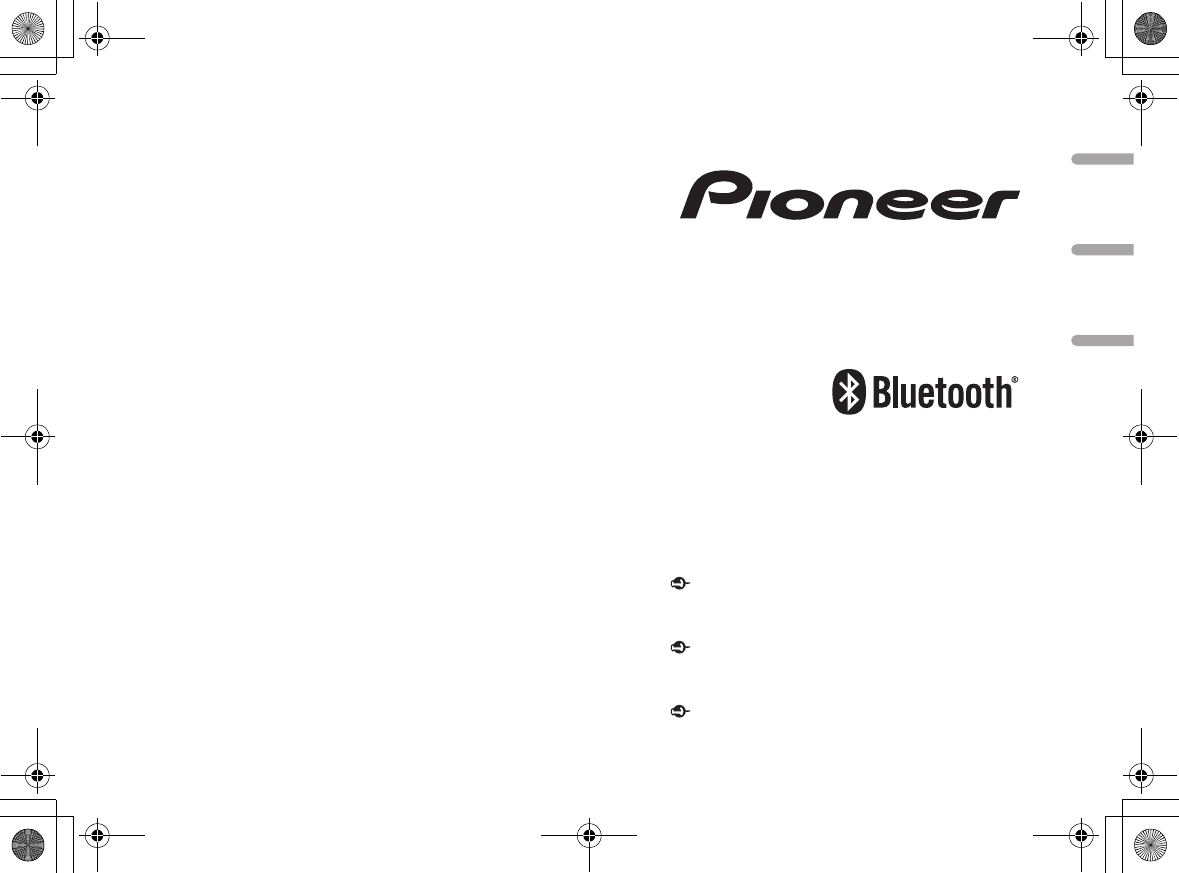
X:\print\Pioneer\17\010COV_30UC.fm
English Français Español
MVH-290BT/MVH-291BT
127075007028_(B6_Horizon)
DIGITAL MEDIA RECEIVER
RÉCEPTEUR MÉDIA NUMÉRIQUE
RECEPTOR DE MEDIOS DIGITALES
MVH-290BT
MVH-291BT
Owner’s Manual
Mode d’emploi
Manual de instrucciones
Important (Serial number)
The serial number is located on the bottom of this unit. For your own
security and convenience, be sure to record this number on the
enclosed warranty card.
Important (Numéro de série)
Le numéro de série se trouve au bas de cet appareil. Pour votre sécurité
et votre commodité, veillez à noter ce numéro sur la carte de garantie
fournie.
Importante (Número de serie)
El número de serie se encuentra en la parte inferior de esta unidad. Por
su propia seguridad y comodidad, asegúrese de anotar este número en
la tarjeta de garantía que se adjunta.
010COV_30UC.fm Page 1 Friday, April 22, 2016 12:02 PM
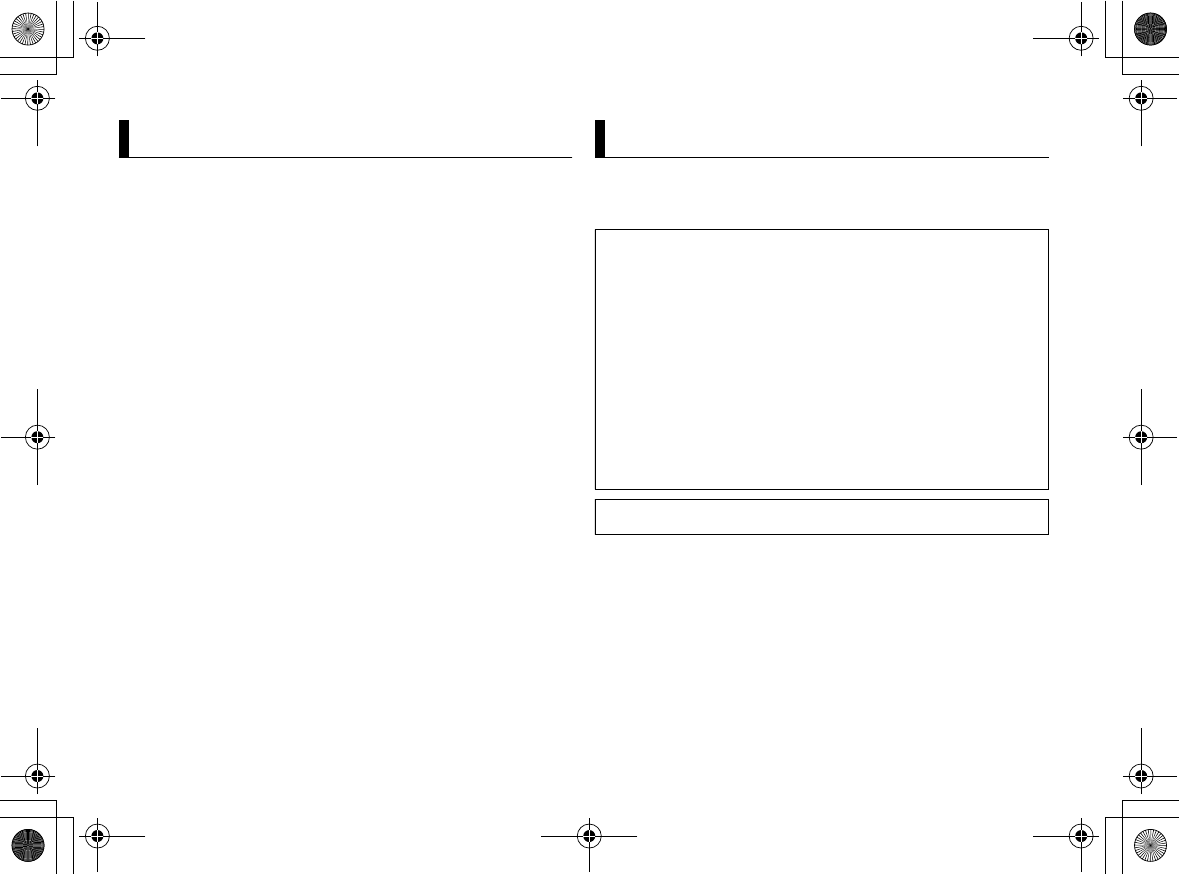
Table of Contents
2
C:\Program Files (x86)\Adobe\AdobeFrameMaker12\Structure\xml\Pioneer\1.0\020Chapter.fm
KM637
KM637_UC
En
Before You Start.......................................................................... 2
Getting Started .......................................................................... 3
Radio ............................................................................................ 5
USB/AUX...................................................................................... 6
Bluetooth..................................................................................... 7
Settings...................................................................................... 10
FUNCTION settings ............................................................... 10
AUDIO settings....................................................................... 11
SYSTEM settings .................................................................... 12
Connections/Installation........................................................ 13
Additional Information........................................................... 16
About this manual:
•In the following instructions, a USB memory or USB audio player are referred
to as “USB device”.
Before You Start
Thank you for purchasing this PIONEER product
To ensure proper use, please read through this manual before using this product. It is
especially important that you read and observe WARNINGs and CAUTIONs in this manual.
Please keep the manual in a safe and accessible place for future reference.
FCC ID: AJDK096
MODEL NO.: MVH-290BT/MVH-291BT
IC: 775E-K096
This device complies with Part 15 of FCC Rules and Innovation, Science, and Economic
Development Canada licence-exempt RSS standard(s). Operation is subject to the
following two conditions: (1) this device may not cause interference, and (2) this device
must accept any interference, including interference that may cause undesired operation
of this device.
This transmitter must not be co-located or operated in conjunction with any other
antenna or transmitter.
The Bluetooth antenna cannot be removed (or replaced) by user.
This equipment complies with FCC/ISED radiation exposure limits set forth for an
uncontrolled environment and meets the FCC radio frequency (RF) Exposure Guidelines
and RSS-102 of the ISED radio frequency (RF) Exposure rules. This equipment has very
low levels of RF energy that it deemed to comply without maximum permissive exposure
evaluation (MPE). But it is desirable that it should be installed and operated keeping the
radiator at least 20cm or more away from person’s body (excluding extremities: hands,
wrists, feet and ankles).
Alteration or modifications carried out without appropriate authorization may invalidate
the user’s right to operate the equipment.
PioneerTest.book Page 2 Wednesday, May 11, 2016 9:52 AM
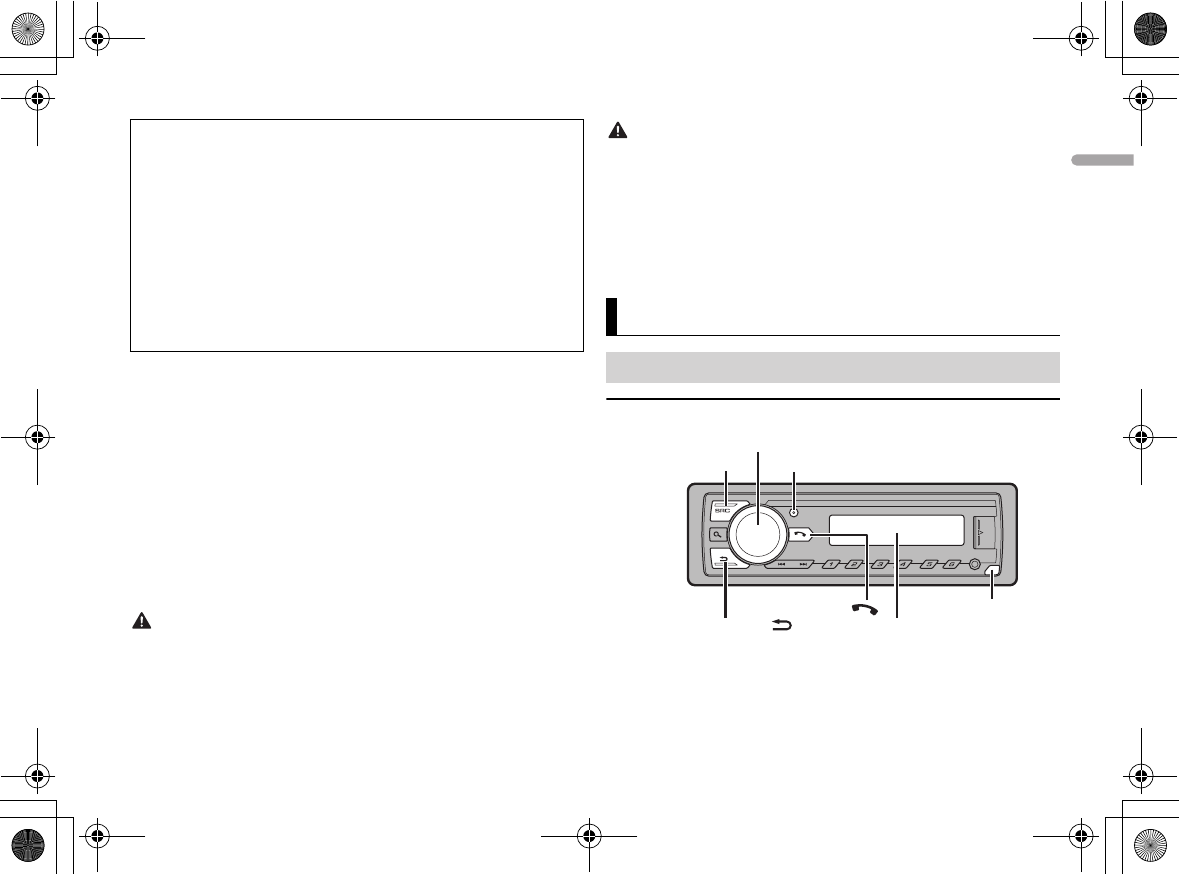
Note
This equipment has been tested and found to comply with the limits for a Class B digital
device, pursuant to Part 15 of the FCC Rules. These limits are designed to provide
reasonable protection against harmful interference in a residential installation. This
equipment generates, uses and can radiate radio frequency energy and, if not installed
and used in accordance with the instructions, may cause harmful interference to radio
communications. However, there is no guarantee that interference will not occur in a
particular installation. If this equipment does cause harmful interference to radio or
television reception, which can be determined by turning the equipment off and on, the
user is encouraged to try to correct the interference by one or more of the following
measures:
–Reorient or relocate the receiving antenna.
–Increase the separation between the equipment and receiver.
–Connect the equipment into an outlet on a circuit different from that to which the
receiver is connected.
–Consult the dealer or an experienced radio/TV technician for help.
3
C:\Program Files (x86)\Adobe\AdobeFrameMaker12\Structure\xml\Pioneer\1.0\020Chapter.fm
KM637
KM637_UC
En
English
The Safety of Your Ears is in Your Hands
Get the most out of your equipment by playing it at a safe level—a level that lets the sound
come through clearly without annoying blaring or distortion and, most importantly,
without affecting your sensitive hearing. Sound can be deceiving.
Over time, your hearing “comfort level” adapts to higher volumes of sound, so what sounds
“normal” can actually be loud and harmful to your hearing. Guard against this by setting
your equipment at a safe level BEFORE your hearing adapts.
ESTABLISH A SAFE LEVEL:
•Set your volume control at a low setting.
•Slowly increase the sound until you can hear it comfortably and clearly, without distortion.
•Once you have established a comfortable sound level, set the dial and leave it there.
BE SURE TO OBSERVE THE FOLLOWING GUIDELINES:
•Do not turn up the volume so high that you can’t hear what’s around you.
•Use caution or temporarily discontinue use in potentially hazardous situations.
•Do not use headphones while operating a motorized vehicle; the use of headphones may
create a traffic hazard and is illegal in many areas.
WARNING
• Do not attempt to install or service this product by yourself. Installation or servicing
of this product by persons without training and experience in electronic equipment
and automotive accessories may be dangerous and could expose you to the risk of
electric shock, injury or other hazards.
•Do not attempt to operate the unit while driving. Make sure to pull off the road and park
your vehicle in a safe location before attempting to use the controls on the device.
CAUTION
•Do not allow this unit to come into contact with moisture and/or liquids. Electrical shock
could result. Also, damage to this unit, smoke, and overheating could result from contact
with liquids.
•Always keep the volume low enough to hear outside sounds.
If you experience problems
Should this unit fail to work properly, please contact your dealer or nearest authorized
PIONEER Service Station.
Getting Started
Basic operation
MVH-290BT/291BT
SRC (source)/OFF
Detach button
Display window
M.C. (multi-control) dial
BAND/DIMMER
Display button/DISP OFF*
* This button is referred to as DISP in the manual.
PioneerTest.book Page 3 Wednesday, May 11, 2016 9:52 AM
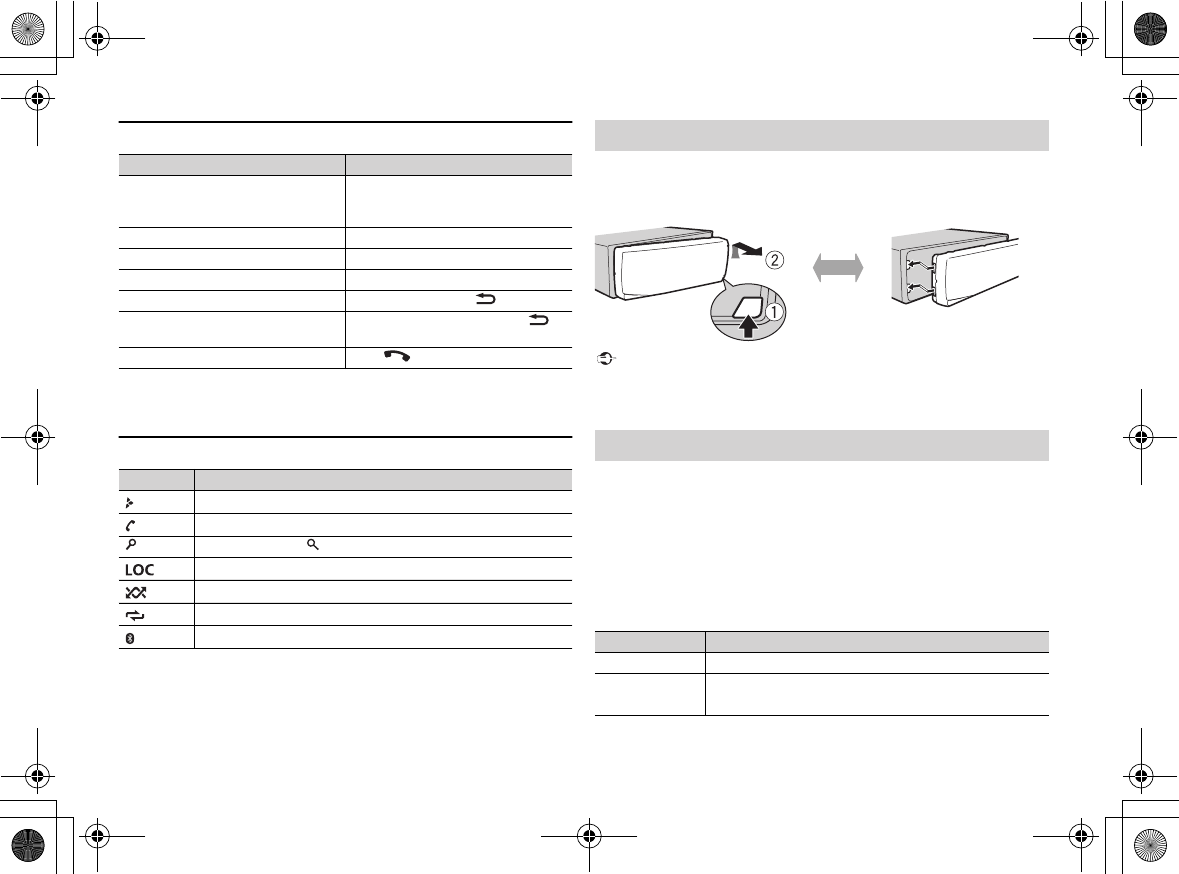
4
C:\Program Files (x86)\Adobe\AdobeFrameMaker12\Structure\xml\Pioneer\1.0\020Chapter.fm
KM637
KM637_UC
En
Frequently used operations
Purpose Operation
Turn on the power* Press SRC/OFF to turn on the power.
Press and hold SRC/OFF to turn off the
power.
Adjust the volume Turn the M.C. dial.
Select a source Press SRC/OFF repeatedly.
Change the display information Press DISP repeatedly.
Return to the previous display/list Press BAND/DIMMER .
Return to the normal display from the
menu
Press and hold BAND/DIMMER .
Answering/ending a call Press .
* When this unit’s blue/white lead is connected to the vehicle’s auto-antenna relay control
terminal, the vehicle’s antenna extends when this unit’s source is turned on. To retract the
antenna, turn the source off.
Display indication
Indication Description
Appears when a lower tier of the menu or folder exists.
Appears when the automatic answering function is set (page 9).
Appears when the button is pressed.
Appears when the local seek tuning function is set (page 11).
Appears when random/shuffle play is set.
Appears when repeat play is set.
Appears when a Bluetooth connection is made (page 7).
Detaching the front panel
Detach the front panel to prevent theft. Remove any cables and devices
attached to the front panel and turn off the unit before detaching it.
Detach Attach
Important
•Avoid subjecting the front panel to excessive shock.
•Keep the front panel out of direct sunlight and high temperatures.
•Always store the detached front panel in a protective case or bag.
Setup menu
When you turn the ignition switch to ON after installation, [SET UP :YES]
appears in the display.
1Press the M.C. dial.
The setup menu disappears after 30 seconds of no operation. If you prefer
not to set at this time, turn the M.C. dial to select [NO], then press to
confirm.
2Turn the M.C. dial to select the options, then press to confirm.
To proceed to the next menu option, you need to confirm your selection.
Menu Item Description
CLOCK SET Set the clock.
FM STEP Select the FM tuning step from 100 kHz or 50 kHz.
[100], [50]
PioneerTest.book Page 4 Wednesday, May 11, 2016 9:52 AM
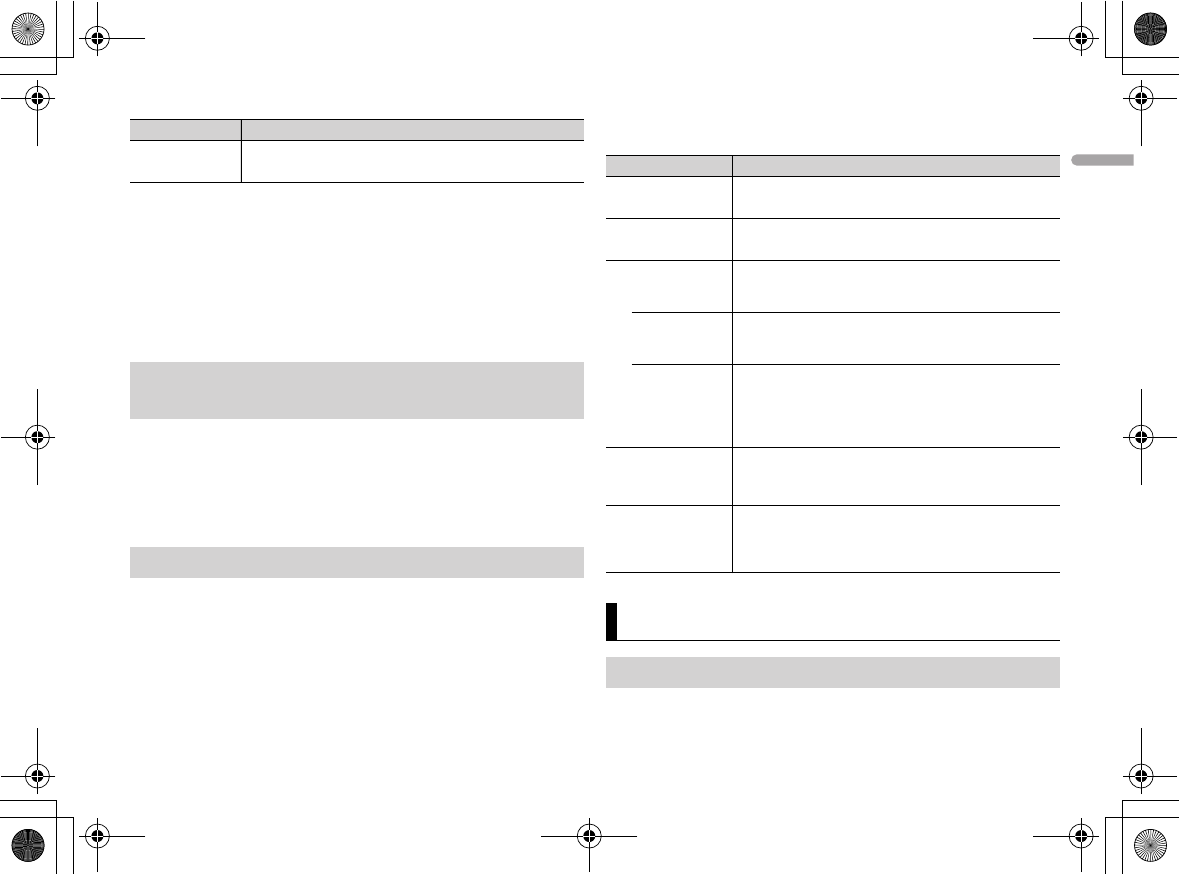
5
C:\Program Files (x86)\Adobe\AdobeFrameMaker12\Structure\xml\Pioneer\1.0\020Chapter.fm
KM637
KM637_UC
En
English
3[QUIT :YES] appears when all the settings have been made.
To return to the first item of the setup menu, turn the M.C. dial to select
[QUIT :NO], then press to confirm.
4Press the M.C. dial to confirm the settings.
NOTES
•You can cancel the menu setting by pressing SRC/OFF.
•These settings can be made at any time from the SYSTEM settings (page 12) and INITIAL
settings (page 5).
Canceling the demonstration display (DEMO
OFF)
1Press the M.C. dial to display the main menu.
2Turn the M.C. dial to select [SYSTEM], then press to confirm.
3Turn the M.C. dial to select [DEMO OFF], then press to confirm.
4Turn the M.C. dial to select [YES], then press to confirm.
INITIAL settings
1Press and hold SRC/OFF until the unit turns off.
2Press the M.C. dial to display the main menu.
3Turn the M.C. dial to select [INITIAL], then press to confirm.
4Turn the M.C. dial to select an option, then press to confirm.
AM STEP Select the AM tuning step from 10 kHz or 9 kHz.
[10], [9]
Menu Item Description NOTE
The options vary depending on the unit.
Menu Item Description
FM STEP Select the FM tuning step from 100 kHz or 50 kHz.
[100], [50]
AM STEP Select the AM tuning step from 10 kHz or 9 kHz.
[10], [9]
SP-P/O MODE Select when there is a full-range speaker connected to
the rear speaker output leads and there is a subwoofer
connected to the RCA output.
[REAR/SUB.W]
[SUB.W/SUB.W] Select when there is a passive subwoofer connected
directly to the rear speaker output leads and there is a
subwoofer connected to the RCA output.
[REAR/REAR] Select when there are full-range speakers connected to
the rear speaker output leads and RCA output. If there is
a full-range speaker connected to the rear speaker
output leads, and the RCA output is not used, you may
select either [REAR/SUB.W] or [REAR/REAR].
DIM SETTING Change the display brightness.
[SYNC CLOCK],
[MANUAL]
SYSTEM RESET Select [YES] to initialize the unit settings. The unit will be
restarted automatically.
(Some of the settings may be retained even after
resetting the unit.)
[YES], [CANCEL]
Radio
Receiving preset stations
1Press SRC/OFF to select [RADIO].
PioneerTest.book Page 5 Wednesday, May 11, 2016 9:52 AM
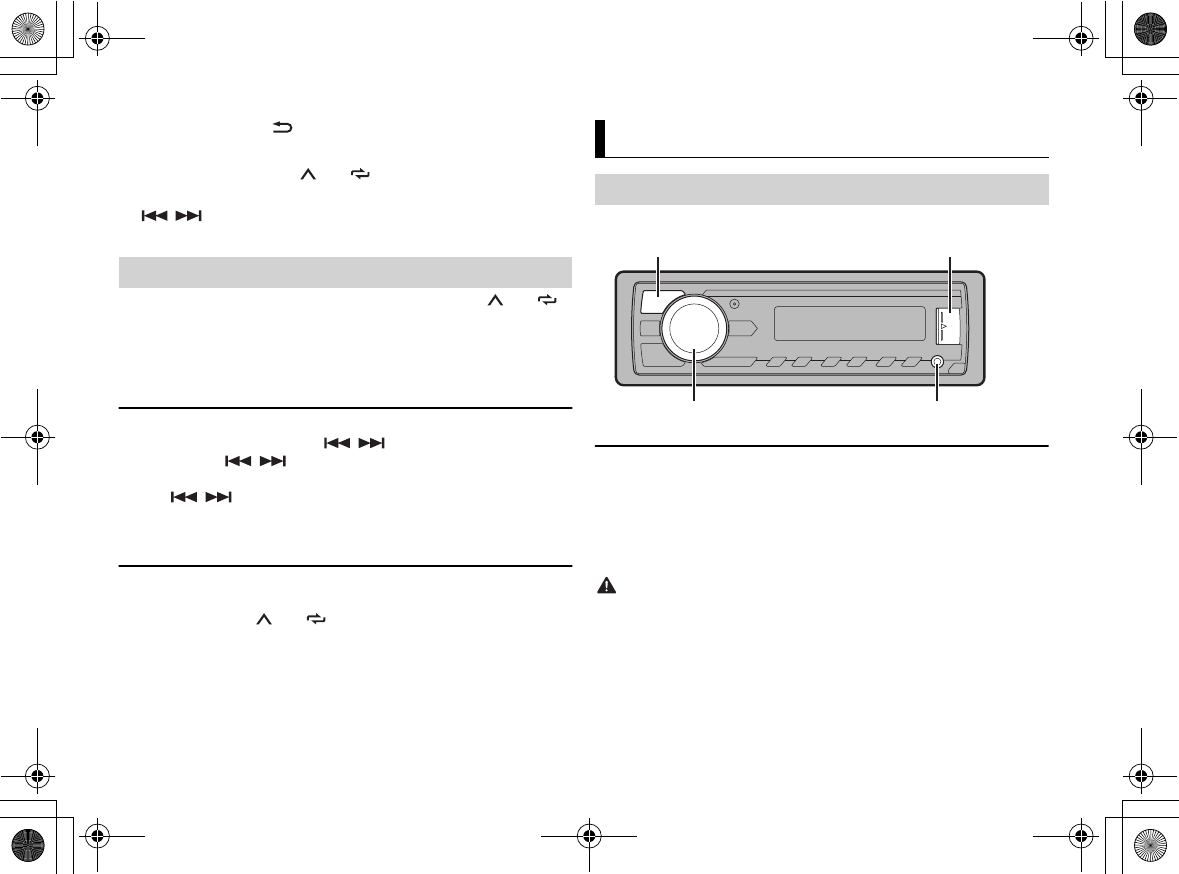
6
C:\Program Files (x86)\Adobe\AdobeFrameMaker12\Structure\xml\Pioneer\1.0\020Chapter.fm
KM637
KM637_UC
En
2Press BAND/DIMMER to select the band from [FM1], [FM2], [FM3] or
[AM].
3Press a number button (1/ to 6/ ).
TIP
The / buttons can be also used to select a preset station when [SEEK] is set to
[PCH] in the FUNCTION settings (page 11).
Best stations memory (BSM)
The six strongest stations are stored on the number buttons (1/ to 6/ ).
1After selecting the band, press the M.C. dial to display the main menu.
2Turn the M.C. dial to select [FUNCTION], then press to confirm.
3Turn the M.C. dial to select [BSM], then press to confirm.
To seek a station manually
1After selecting the band, press / to select a station.
Press and hold / then release to seek an available station.
Scanning stops when the unit receives a station. To cancel seek tuning,
press / .
NOTE
[SEEK] needs to be set to [MAN] in the FUNCTION settings (page 11).
To store stations manually
1While receiving the station you want to store, press and hold one of the
number buttons (1/ to 6/ ) until it stops flashing.
USB/AUX
Playing back
Disconnect headphones from the device before connecting it to the unit.
AUX input jack (3.5 mm stereo jack)
USB port
SRC (source)/OFF
M.C. (multi-control) dial
USB devices (including Android)
1Open the USB port cover.
2Plug in the USB.
NOTE
To automatically switch to [USB] source when a USB device is connected to the unit, set
[USB AUTO] to [ON] in the SYSTEM settings (page 12).
CAUTION
Use an optional Pioneer USB cable (CD-U50E) to connect the USB device as any device
connected directly to the unit will protrude out from the unit, which could be dangerous.
Before removing the device, stop playback.
AOA connections
A device installed with Android OS 5.0 or later can be connected to the unit via
AOA, using the cable supplied with the device.
PioneerTest.book Page 6 Wednesday, May 11, 2016 9:52 AM
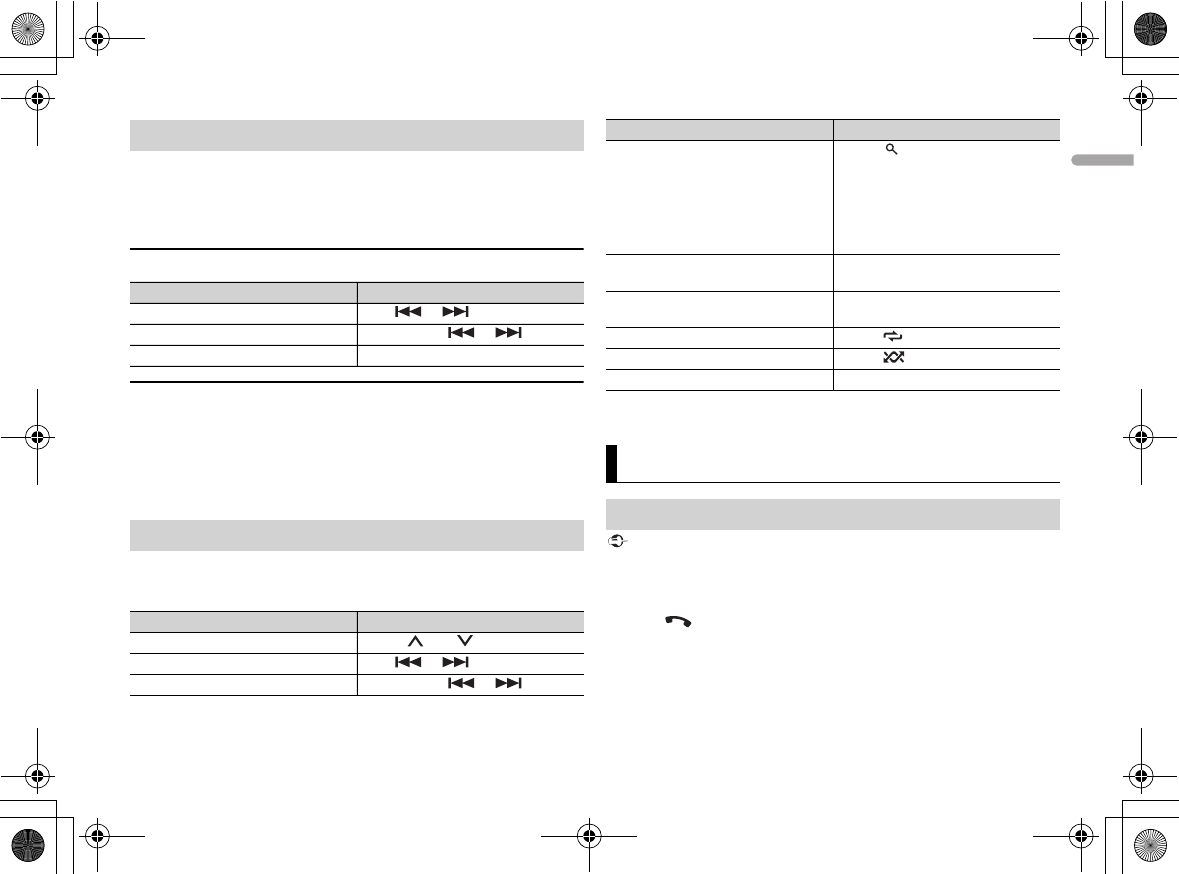
Listening to music on Android
7
C:\Program Files (x86)\Adobe\AdobeFrameMaker12\Structure\xml\Pioneer\1.0\020Chapter.fm
KM637
KM637_UC
En
English
This function is compatible with devices that have Android OS 5.0 or later
installed and also support Bluetooth SPP (Serial Port Profile) and AOA (Android
Open Accessory) 2.0.
1Press SRC/OFF to select [ANDROID].
Basic operations
Purpose Operation
Select a track Press or .
Fast forward or reverse Press and hold or .
Pause/resume playback Press 4/PAUSE.
AUX
1Insert the stereo mini plug into the AUX input jack.
2Press SRC/OFF to select [AUX] as the source.
NOTE
If [AUX] is set to [OFF] in the SYSTEM settings, [AUX] cannot be selected as a source
(page 12).
Operations
You can make various adjustments in the FUNCTION settings (page 10).
Note that the following operations do not work for an AUX device. To operate
an AUX device, use the device itself.
Purpose Operation
Select a folder/album* Press 1/ or 2/ .
Select a track/song (chapter) Press or .
Fast forward or reverse Press and hold or .
Search for a file from a list 1Press to display the list.
2Turn the M.C. dial to select the
desired file (folder) name or
category, then press to confirm.
3Turn the M.C. dial to select the
desired file, then press to confirm.
Playback starts.
View a list of the files in the selected
folder/category*
Press the M.C. dial when a folder/
category is selected.
Play a song in the selected folder/
category*
Press and hold the M.C. dial when a
folder/category is selected.
Repeat play Press 6/.
Random/shuffle play Press 5/.
Pause/resume playback Press 4/PAUSE.
* Compressed audio files only
Bluetooth
Bluetooth connection
Important
If three or more Bluetooth devices (e.g. a phone and separate audio player) are connected,
they may not work properly.
1Turn on the Bluetooth function of the device.
2Press to display the phone menu.
3Turn the M.C. dial to select [BT SETTING], then press to confirm.
4Turn the M.C. dial to select [ADD DEVICE], then press to confirm.
The unit starts to search for available devices.
•To cancel searching, press the M.C. dial.
Purpose Operation
PioneerTest.book Page 7 Wednesday, May 11, 2016 9:52 AM
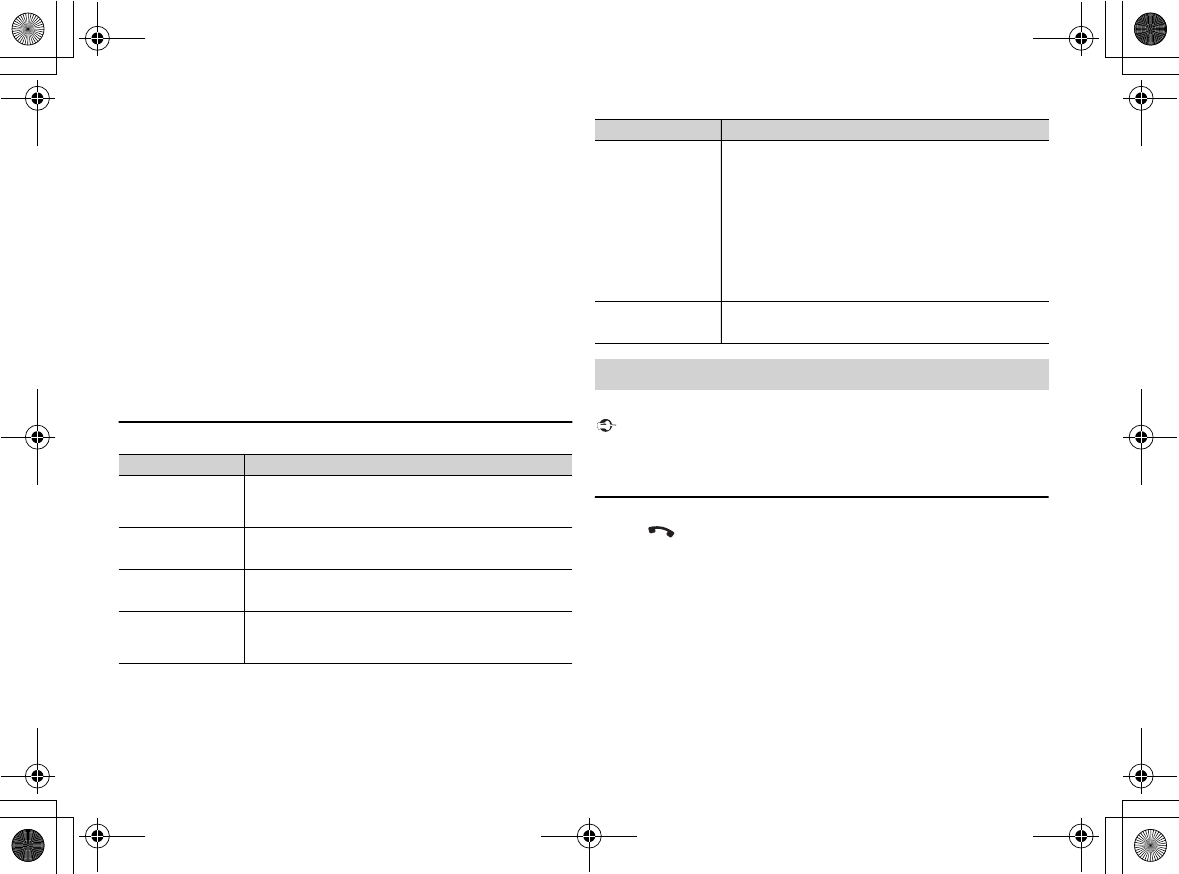
8
C:\Program Files (x86)\Adobe\AdobeFrameMaker12\Structure\xml\Pioneer\1.0\020Chapter.fm
KM637
KM637_UC
En
•If the desired device is not in the list, select [RE-SEARCH].
•If there is no device available, [NOT FOUND] appears in the display.
5Turn the M.C. dial to select a device, then press to confirm.
Press and hold the M.C. dial to switch the displayed device information
between the Bluetooth device address and device name.
6Select [Pioneer BT Unit] shown in the device display.
7Make sure the same 6-digit number appears on this unit and the device,
then select “Yes” on the device.
NOTE
Depending on the device, the PIN code is required in step 7. In this case, input [0000].
TIP
The Bluetooth connection can be also made by detecting the unit from the Bluetooth
device. To do so, [VISIBLE] in the Bluetooth settings needs to be set to [ON]. For details on a
Bluetooth device operations, refer to the operating instructions supplied with the
Bluetooth device.
Bluetooth settings
Menu Item Description
BT CONNECT Display the paired Bluetooth devices. “*” appears on the
device name when the Bluetooth connection is
established.
[ON], [OFF]
ADD DEVICE Register a new device.
A.CONN Select [ON] to connect to a Bluetooth device
automatically.
[ON], [OFF]
VISIBLE Select [ON] so that a Bluetooth device can detect the
unit when the unit is connected via Bluetooth to another
device.
[ON], [OFF]
PIN CODE Change the PIN code.
1Press the M.C. dial to display the setting mode.
2Turn the M.C. dial to select a number.
3Press the M.C. dial to move the cursor to the next
position.
4After inputting the PIN code, press and hold the M.C.
dial.
After inputting the PIN code, pressing the M.C. dial
returns you to the PIN code input display, and you can
change the PIN code.
DEV. INFO Switch the device information on the display between
the device name and Bluetooth device address.
Bluetooth telephone
First, make a Bluetooth connection with the Bluetooth telephone (page 7).
Important
•Leaving the unit on standby to connect to your phone via Bluetooth while the engine is
not running can drain the vehicle’s battery.
•Be sure to park your vehicle in a safe place and apply the parking brake before operation.
To make a phone call
1Press to display the phone menu.
2Turn the M.C. dial to select [RECENTS] or [PHONE BOOK], then press to
confirm.
If you select [PHONE BOOK], proceed to step 4.
3Turn the M.C. dial to select [MISSED], [DIALED] or [RECEIVED], then press
to confirm.
4Turn the M.C. dial to select a name or phone number, then press to
confirm.
The phone call starts.
Menu Item Description
PioneerTest.book Page 8 Wednesday, May 11, 2016 9:52 AM
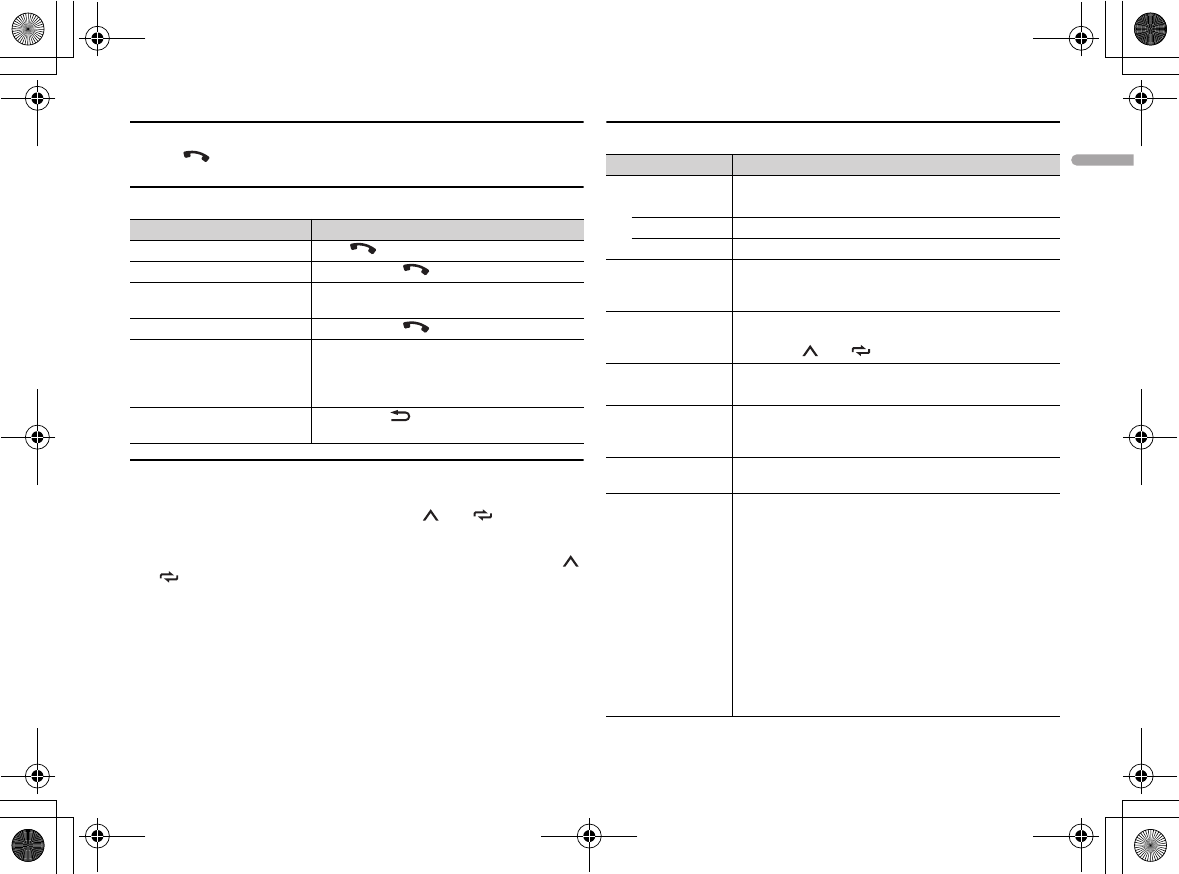
9
C:\Program Files (x86)\Adobe\AdobeFrameMaker12\Structure\xml\Pioneer\1.0\020Chapter.fm
KM637
KM637_UC
En
English
To answer an incoming call
1Press when a call is received.
Basic operations
Purpose Operation
End a call Press .
Reject an incoming call Press and hold when a call is received.
Switch between the current
caller and a caller on hold
Press the M.C. dial.
Cancel a caller on hold Press and hold .
Adjust the volume of the
caller’s voice (When private
mode is on, this function is not
available.)
Turn the M.C. dial during the call.
Turn the private mode on or
off
Press BAND/ during the call.
To preset phone numbers
1Select a phone number from a phone book or call history.
2Press and hold one of the number buttons (1/ to 6/ ).
The contact is stored in the selected preset number.
To make a call using a preset number, press one of the number buttons (1/
to 6/), then press the M.C. dial.
Phone menu
Menu Item Description
RECENTS Display the missed call history.
[MISSED]
[DIALED] Display the dialed call history.
[RECEIVED] Display the received call history.
PHONE BOOK*1 Display the contacts which have been transferred from
your phone. Set [VISIBLE] in the Bluetooth settings to
[ON] to browse the contacts via this unit.
PRESET 1-6 Recall the preset phone numbers. You can also recall the
preset phone numbers by pressing one of the number
buttons (1/ to 6/ ).
A.ANSR Select [ON] to answer an incoming call automatically.
[ON], [OFF]
R.TONE Select [ON] if the ring tone does not come out from the
car speakers. Depending on the connected phone, this
function may not work.
[ON], [OFF]
PB INVT Invert the order of names in the phone book (name
view).
PB A.SYNC Select whether or not to transfer the contacts from your
phone automatically when your phone is connected to
the unit.
•When connected for the first time, the contacts from
your phone are transferred automatically, regardless of
the [PB A.SYNC] setting.
•If you switch from [ON] to [OFF], the auto
synchronization will not be performed on the next
connection.
•If you switch from [OFF] to [ON], the auto
synchronization will be performed when your phone is
connected to the unit.
•During the auto synchronization, you cannot cancel
the synchronization, even if you select [OFF].
[ON], [OFF]
PioneerTest.book Page 9 Wednesday, May 11, 2016 9:52 AM
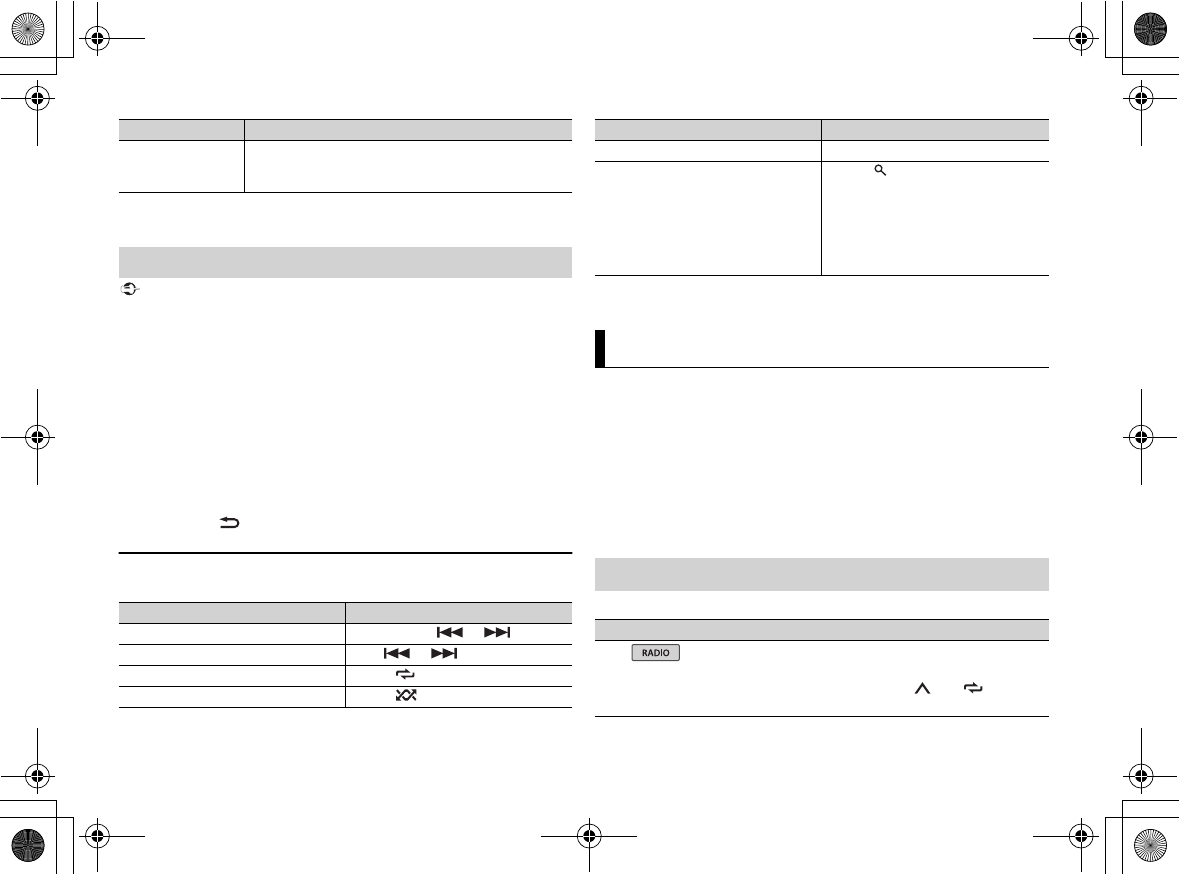
10
C:\Program Files (x86)\Adobe\AdobeFrameMaker12\Structure\xml\Pioneer\1.0\020Chapter.fm
KM637
KM637_UC
En
*1 The contacts on your phone will normally be transferred automatically when the phone
is connected. If they are not, use your phone to transfer the contacts.
Bluetooth audio
Important
•Depending on the Bluetooth audio player connected to this unit, the available operations
will be limited to the following two levels:
– A2DP (Advanced Audio Distribution Profile) can only play back songs on your audio
player.
– AVRCP (Audio/Video Remote Control Profile) can perform functions such as playback,
pause, select song, etc.
•The sound of the Bluetooth audio player will be muted when the phone is in use.
•When the Bluetooth audio player is in use, you cannot connect to a Bluetooth telephone
automatically.
•Depending on the type of Bluetooth audio player you have connected to this unit,
operation and information displayed may vary based on availability and functionality.
1Make a Bluetooth connection with the Bluetooth audio player.
2Press SRC/OFF to select [BT AUDIO] as the source.
3Press BAND/ to start playback.
Basic operations
You can make various adjustments in the FUNCTION settings (page 10).
Purpose Operation
Fast forward or reverse Press and hold or .
Select a track Press or .
Repeat play* Press 6/.
Random play* Press 5/.
Pause/resume playback Press 4/PAUSE.
Search for a file from a list 1Press to display a list.
2Turn the M.C. dial to select the
desired folder name, then press to
confirm.
3Turn the M.C. dial to select the
desired file, then press to confirm.
Playback starts.
BT SETTING You can adjust various settings for Bluetooth
connections. For details on Bluetooth settings, see
page 8.
Menu Item Description
* Depending on the connected device, these operations may not be available.
Settings
You can adjust various settings in the main menu.
1Press the M.C. dial to display the main menu.
2Turn the M.C. dial to select one of the categories below, then press to
confirm.
•FUNCTION settings (page 10)
•AUDIO settings (page 11)
•SYSTEM settings (page 12)
3Turn the M.C. dial to select the options, then press to confirm.
FUNCTION settings
The menu items vary according to the source.
Menu Item Description
BSM
Store the six strongest stations on the
number buttons (1/ to 6/ )
automatically.
Purpose Operation
PioneerTest.book Page 10 Wednesday, May 11, 2016 9:52 AM
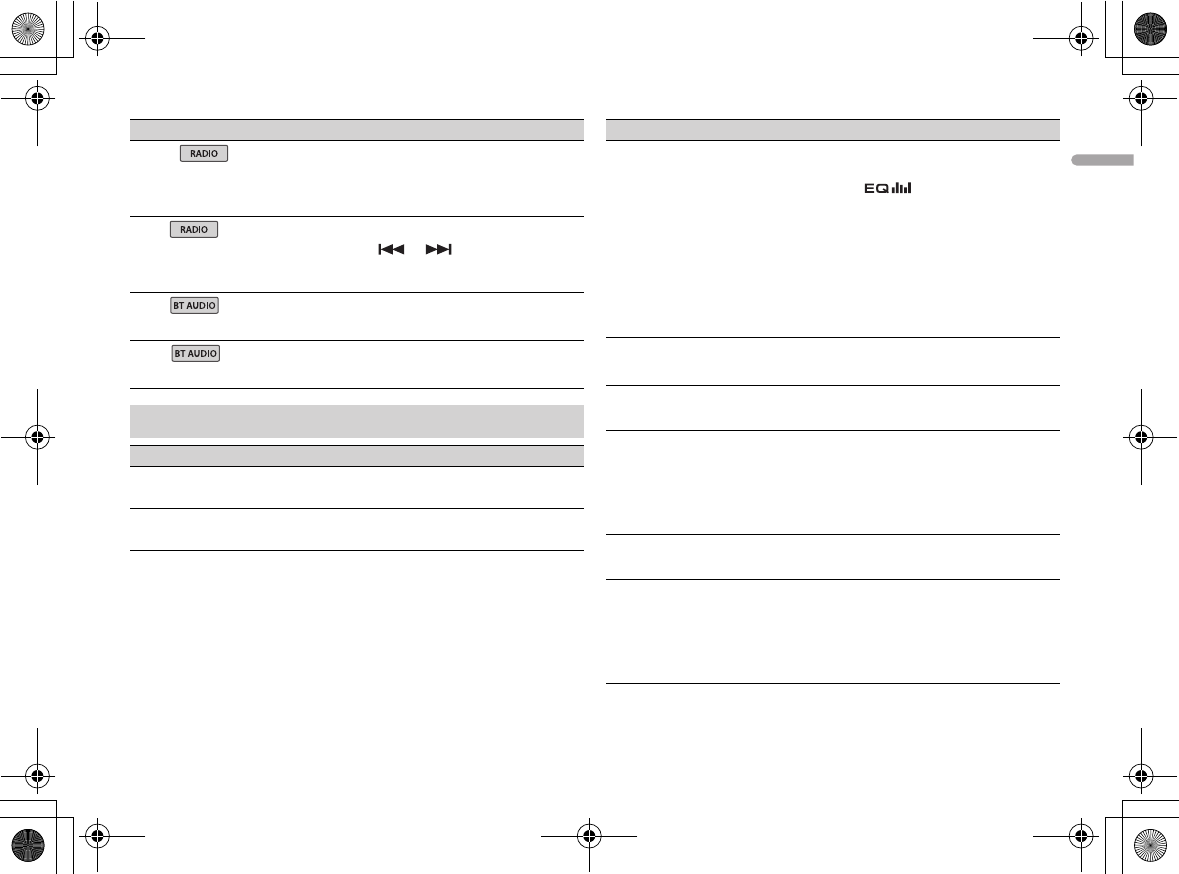
11
C:\Program Files (x86)\Adobe\AdobeFrameMaker12\Structure\xml\Pioneer\1.0\020Chapter.fm
KM637
KM637_UC
En
English
LOCAL
FM: [OFF], [LV1], [LV2], [LV3],
[LV4]
AM: [OFF], [LV1], [LV2]
Restrict the tuning station according to the
signal strength.
SEEK
[MAN], [PCH] Assign or buttons to seek the
stations one by one (manual tuning) or
select a station from the preset channels.
PLAY
Start playback.
STOP
Stop playback.
AUDIO settings
Menu Item Description
FADER*1
Adjust the front and rear speaker balance.
BALANCE
Adjust the left and right speaker balance.
Menu Item Description
EQ SETTING
[SUPER BASS], [POWERFUL],
[NATURAL], [VOCAL],
[CUSTOM1], [CUSTOM2],
[FLAT]
Select an equalizer band and
level for further customizing.
Equalizer band: [80HZ],
[250HZ], [800HZ], [2.5KHZ],
[8KHZ]
Equalizer level: [+6] to [–6]
You can also switch the equalizer by
pressing repeatedly.
LOUDNESS
[OFF], [LOW], [MID], [HI] Compensate for clear sound at low volume.
SUB.W*2
[NOR], [REV], [OFF] Select the subwoofer phase.
SUB.W CTRL*2*3
Cut-off frequency: [50HZ],
[63HZ], [80HZ], [100HZ],
[125HZ], [160HZ], [200HZ]
Output level: [–24] to [+6]
Slope level: [–12], [–24]
Only frequencies lower than those in the
selected range are output from the
subwoofer.
BASS BOOST
[0] to [+6] Select the bass boost level.
HPF SETTING
Cut-off frequency: [OFF],
[50HZ], [63HZ], [80HZ],
[100HZ], [125HZ], [160HZ],
[200HZ]
Slope level: [–12], [–24]
Only frequencies higher than the high-pass
filter (HPF) cutoff are output from the
speakers.
Menu Item Description
PioneerTest.book Page 11 Wednesday, May 11, 2016 9:52 AM
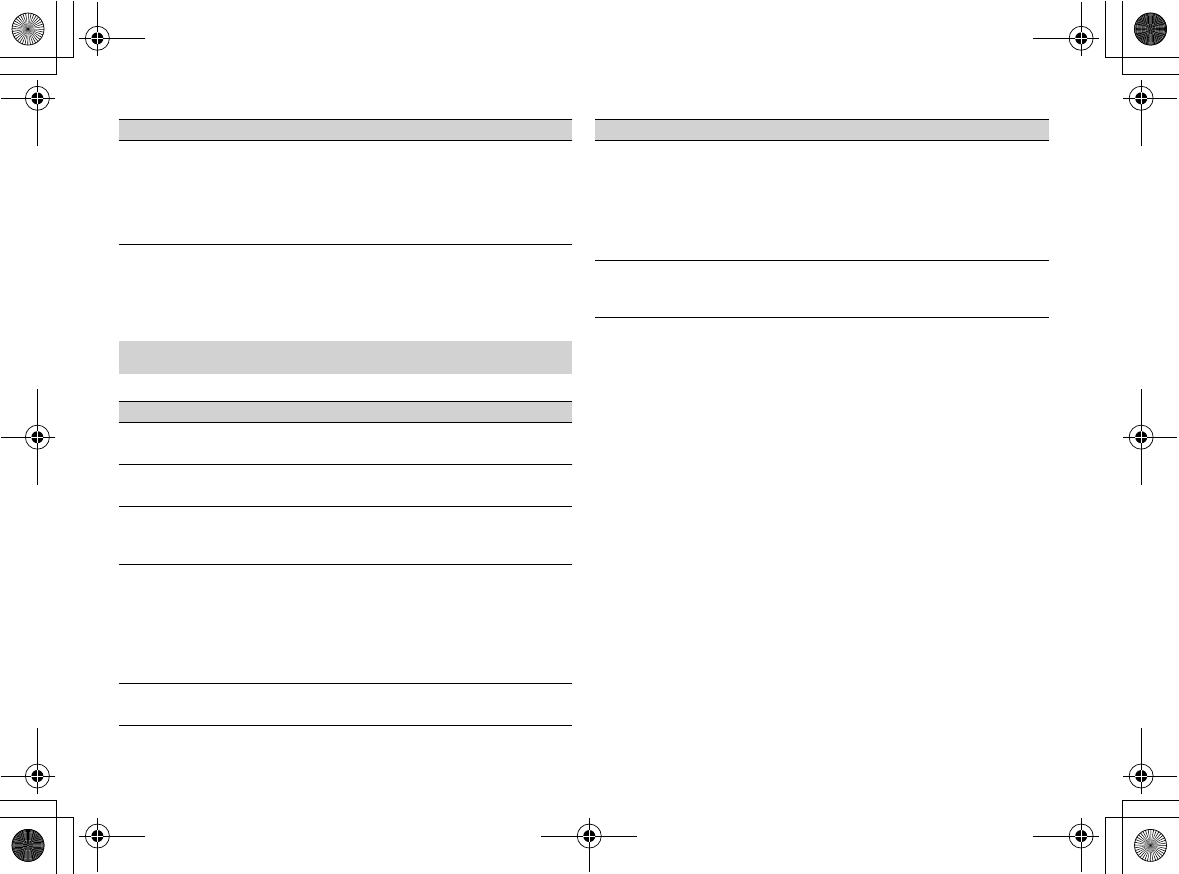
12
C:\Program Files (x86)\Adobe\AdobeFrameMaker12\Structure\xml\Pioneer\1.0\020Chapter.fm
KM637
KM637_UC
En
*1 Not available when [SUB.W/SUB.W] is selected in [SP-P/O MODE] in the INITIAL settings
(page 5).
*2 Not available when [REAR/REAR] is selected in [SP-P/O MODE] in the INITIAL settings
(page 5).
*3 Not available when [OFF] is selected in [SUB.W].
SYSTEM settings
You can also access to these menus when the unit is turned off.
Menu Item Description
CLOCK SET
Set the clock (page 4).
12H/24H
[12H], [24H] Select the time notation.
AUX
[ON], [OFF] Set to [ON] when using an auxiliary device
connected to the unit.
USB AUTO
[ON], [OFF] Select [ON] to automatically switch to
[USB] source when a USB device/Android is
connected to the unit.
Select [OFF] when a USB device/Android is
being connected to the unit just for
charging.
BT AUDIO
[ON], [OFF] Set the Bluetooth signal on/off.
BT MEM CLEAR
[YES], [CANCEL] Clear the Bluetooth device data (device
information, PIN code, call history, phone
book, preset phone numbers) stored in the
unit.
[CLEARED] appears when data is
successfully deleted.
BT VERSION
Displays the system version of the unit and
the Bluetooth module.
SLA
[+4] to [–4] Adjust the volume level for each source
except RADIO.
Each of the below combinations are set to
the same setting automatically.
•USB, APP (Android)
Menu Item Description Menu Item Description
PioneerTest.book Page 12 Wednesday, May 11, 2016 9:52 AM
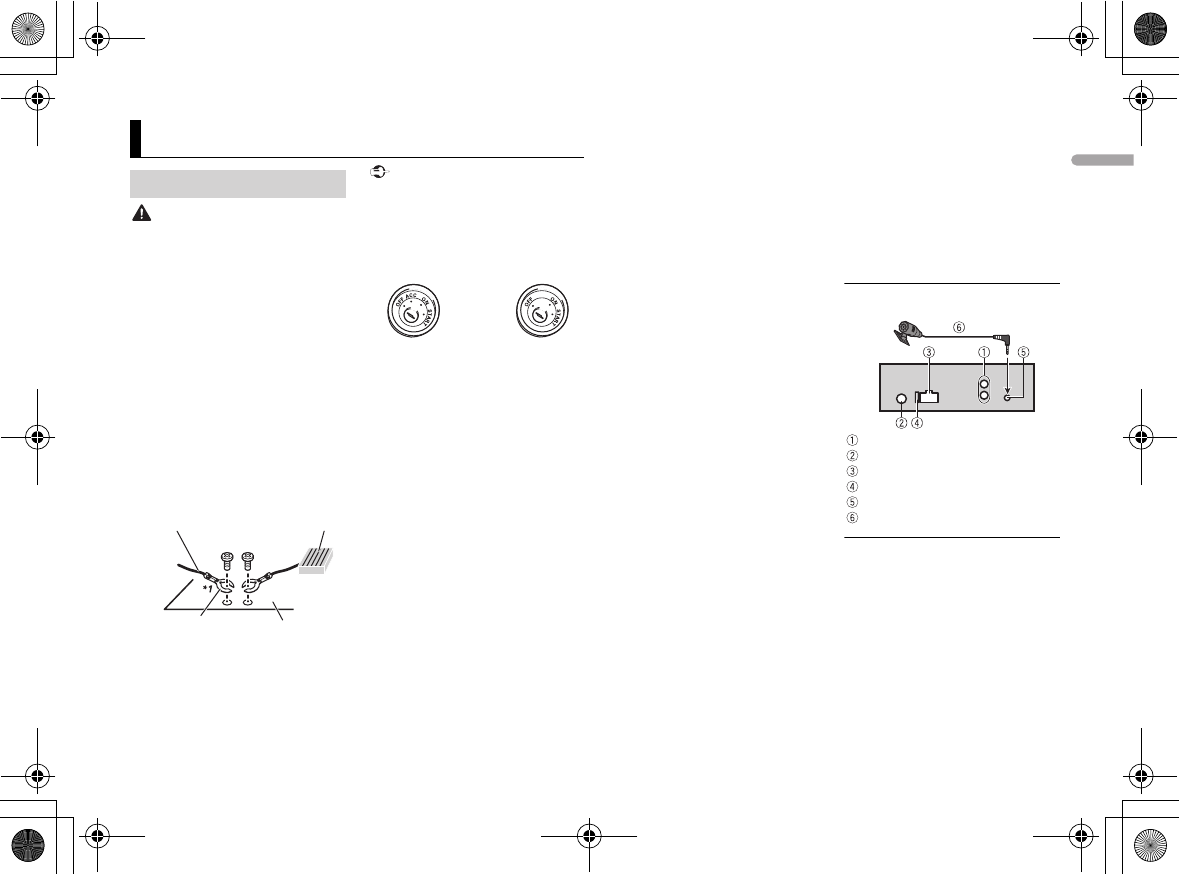
Connections/Installation
Connections
13
C:\Program Files (x86)\Adobe\AdobeFrameMaker12\Structure\xml\Pioneer\1.0\020Chapter.fm
KM637
KM637_UC
En
English
WARNING
•Use speakers over 50 W (output
value) and between 4 Ω to 8 Ω
(impedance value). Do not use 1 Ω to
3 Ω speakers for this unit.
•The black cable is ground. When
installing this unit or power amp
(sold separately), make sure to
connect the ground wire first. Ensure
that the ground wire is properly
connected to metal parts of the car’s
body. The ground wire of the power
amp and the one of this unit or any
other device must be connected to
the car separately with different
screws. If the screw for the ground
wire loosens or falls out, it could
result in fire, generation of smoke or
malfunction.
Important
•When installing this unit in a vehicle
without an ACC (accessory) position
on the ignition switch, failure to
connect the red cable to the terminal
that detects operation of the ignition
key may result in battery drain.
•Use of this unit in conditions other
than the following could result in fire
or malfunction.
–Vehicles with a 12-volt battery and
negative grounding.
–When speaker output is used by 4
channels, use speakers over 50 W
(maximum input power) and
between 4 Ω to 8 Ω (impedance
value). Do not use 1 Ω to 3 Ω
speakers for this unit.
–When rear speaker output is used
by 2 Ω of subwoofer, use speakers
over 70 W (maximum input power).
* Please refer to connection for a
connection method.
•To prevent a short-circuit,
overheating or malfunction, be sure
to follow the directions below.
–Disconnect the negative terminal
of the battery before installation.
–Secure the wiring with cable
clamps or adhesive tape. Wrap
Ground wire POWER AMP
Other devices
(Another electronic
device in the car)
Metal parts of
car’s body
*1 Not supplied for this unit
ACC position No ACC position
adhesive tape around wiring that
comes into contact with metal
parts to protect the wiring.
–Place all cables away from moving
parts, such as the shift lever and
seat rails.
–Place all cables away from hot
places, such as near the heater
outlet.
–Do not connect the yellow cable to
the battery by passing it through
the hole to the engine
compartment.
–Cover any disconnected cable
connectors with insulating tape.
–Do not shorten any cables.
–Never cut the insulation of the
power cable of this unit in order to
share the power with other devices.
The current capacity of the cable is
limited.
–Use a fuse of the rating prescribed.
–Never wire the negative speaker
cable directly to ground.
–Never band together negative
cables of multiple speakers.
•When this unit is on, control signals
are sent through the blue/white
cable. Connect this cable to the
system remote control of an external
power amp or the vehicle’s auto-
antenna relay control terminal (max.
300mA 12 V DC). If the vehicle is
equipped with a glass antenna,
connect it to the antenna booster
power supply terminal.
•Never connect the blue/white cable
to the power terminal of an external
power amp. Also, never connect it to
the power terminal of the auto
antenna. Doing so may result in
battery drain or a malfunction.
•The black cable is ground. Ground
cables for this unit and other
equipment (especially, high-current
products such as power amps) must
be wired separately. If they are not,
an accidental detachment may result
in a fire or malfunction.
This unit
Rear output or subwoofer output
Antenna input
Power cord input
Fuse (10 A)
Microphone input
Microphone (3 m)
Power cord
Perform these connections when not
connecting a rear speaker lead to a
subwoofer.
PioneerTest.book Page 13 Wednesday, May 11, 2016 9:52 AM
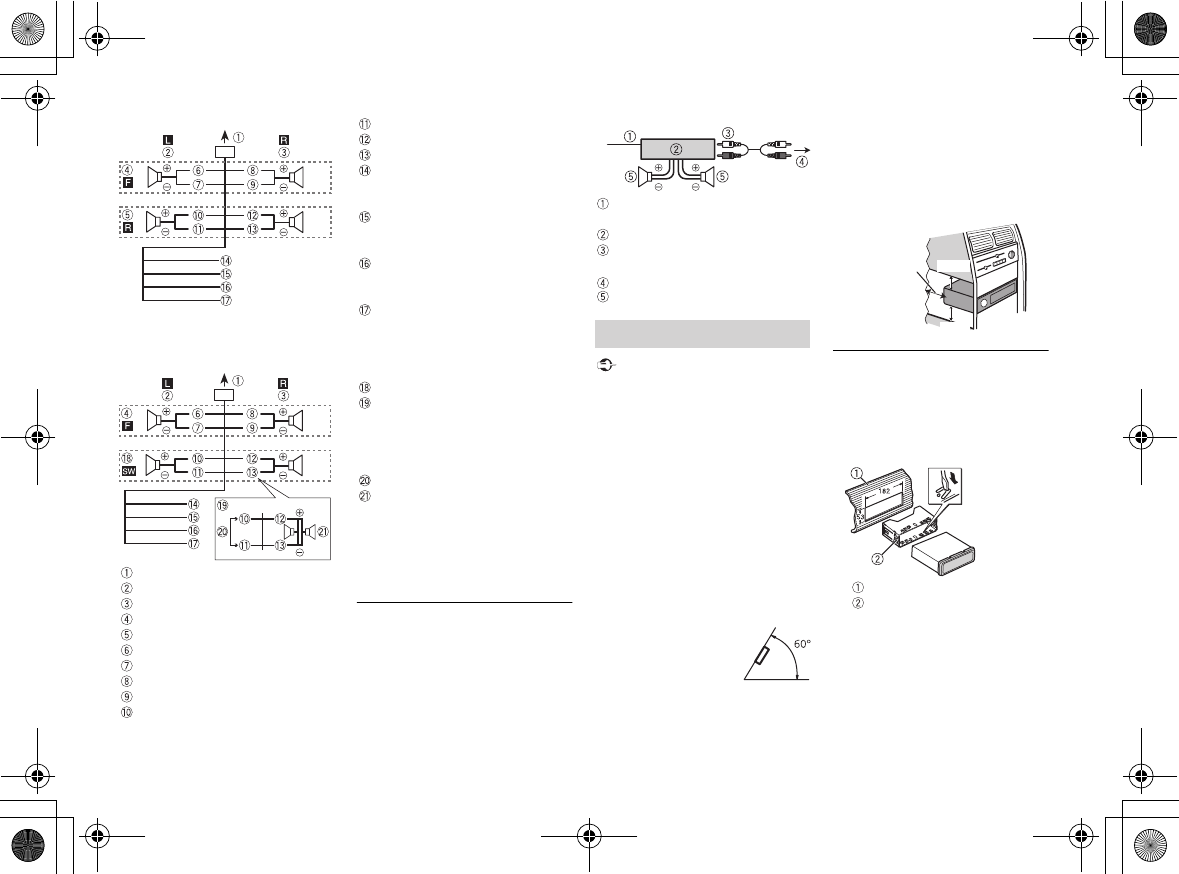
14
C:\Program Files (x86)\Adobe\AdobeFrameMaker12\Structure\xml\Pioneer\1.0\020Chapter.fm
KM637
KM637_UC
En
Perform these connections when
using a subwoofer without the
optional amplifier.
To power cord input
Left
Right
Front speaker
Rear speaker
White
White/black
Gray
Gray/black
Green
Green/black
Violet
Violet/black
Black (chassis ground)
Connect to a clean, paint-free
metal location.
Yellow
Connect to the constant 12 V
supply terminal.
Red
Connect to terminal controlled by
the ignition switch (12 V DC).
Blue/white
Connect to the system control
terminal of the power amp or auto-
antenna relay control terminal
(max. 300 mA 12 V DC).
Subwoofer (4 Ω)
When using a subwoofer of 2 Ω, be
sure to connect the subwoofer to
the violet and violet/black leads of
this unit. Do not connect anything
to the green and green/black leads.
Not used.
Subwoofer (4 Ω) × 2
NOTE
Change the initial menu of this unit.
Refer to [SP-P/O MODE] (page 5). The
subwoofer output of this unit is
monaural.
Power amp (sold separately)
Perform these connections when
using the optional amplifier.
System remote control
Connect to blue/white cable.
Power amp (sold separately)
Connect with RCA cables (sold
separately)
To rear output or subwoofer output
Rear speaker or subwoofer
Installation
Important
•Check all connections and systems
before final installation.
•Do not use unauthorized parts as
this may cause malfunctions.
•Consult your dealer if installation
requires drilling of holes or other
modifications to the vehicle.
•Do not install this unit where:
–it may interfere with operation of
the vehicle.
–it may cause injury to a passenger
as a result of a sudden stop.
•The semiconductor laser will be
damaged if it overheats. Install this
unit away from hot places such as
near the heater outlet.
•Optimum
performance is
obtained when the
unit is installed at an
angle of less than 60°.
•When installing, to ensure proper
heat dispersal when using this unit,
make sure you leave ample space
behind the rear panel and wrap any
loose cables so they are not blocking
the vents.
DIN mount installation
1Insert the supplied mounting
sleeve into the dashboard.
2Secure the mounting sleeve by
using a screwdriver to bend the
metal tabs (90°) into place.
Dashboard
Mounting sleeve
•Make sure that the unit is
installed securely in place. An
unstable installation may cause
skipping or other malfunctions.
Leave ample
space 5 cm
5 cm
PioneerTest.book Page 14 Wednesday, May 11, 2016 9:52 AM
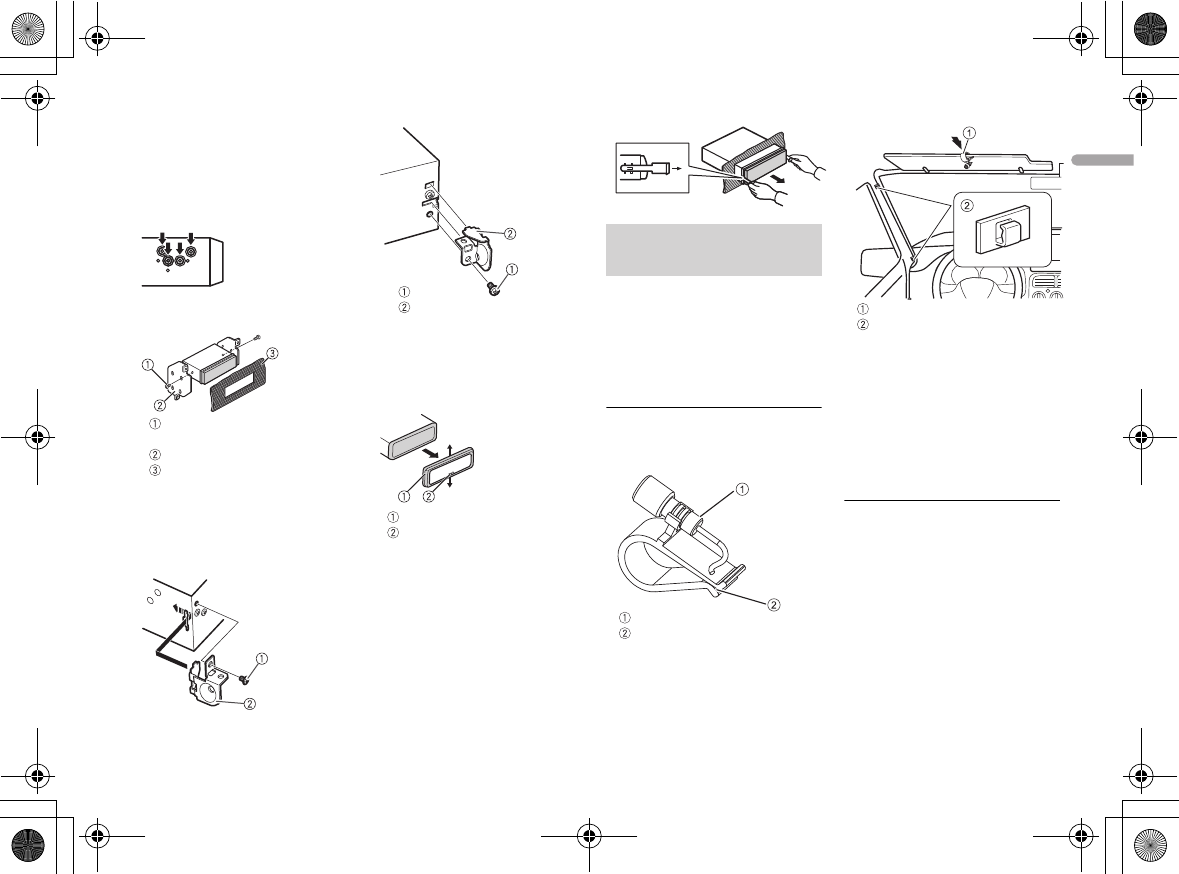
15
C:\Program Files (x86)\Adobe\AdobeFrameMaker12\Structure\xml\Pioneer\1.0\020Chapter.fm
KM637
KM637_UC
En
English
When not using the supplied
mounting sleeve
1Line up the holes on the
mounting bracket with the holes
on the sides of the unit to attach
the bracket.
2Screw in one screw on each side to
hold the unit in place.
Tapping screw (5 mm × 9 mm,
not supplied with product)
Mounting bracket
Dashboard or console
Using the included bracket
Check to make sure that the included
bracket matches your particular
model of vehicle and then attach it to
the unit as shown below.
Removing the unit (installed
with the supplied mounting
sleeve)
1Remove the trim ring.
Trim ring
Notched tab
•Releasing the front panel allows
easier access to the trim ring.
•When reattaching the trim ring,
point the side with the notched
tab down.
2Insert the supplied extraction
keys into both sides of the unit
until they click into place.
3Pull the unit out of the dashboard.
Installing the
microphone
Screw
Bracket •Install the microphone in a place
where its direction and distance
from the driver make it easiest to
pick up the driver’s voice.
•Be sure to turn off (ACC OFF) the
product before connecting the
microphone.
Mounting on the sun visor
1Fit the microphone into the
microphone clip.
2Mount the microphone clip to the
sun visor.
Install the microphone on the sun
visor when it is in the up position. It
cannot recognize the driver’s voice
if the sun visor is in the down
position.
Installation on the steering
column
1Fit the microphone into the
Microphone Base.
Microphone
Microphone clip
Microphone clip
Clamps
Use separately sold clamps to
secure the lead where
necessary inside the vehicle.
PioneerTest.book Page 15 Wednesday, May 11, 2016 9:52 AM
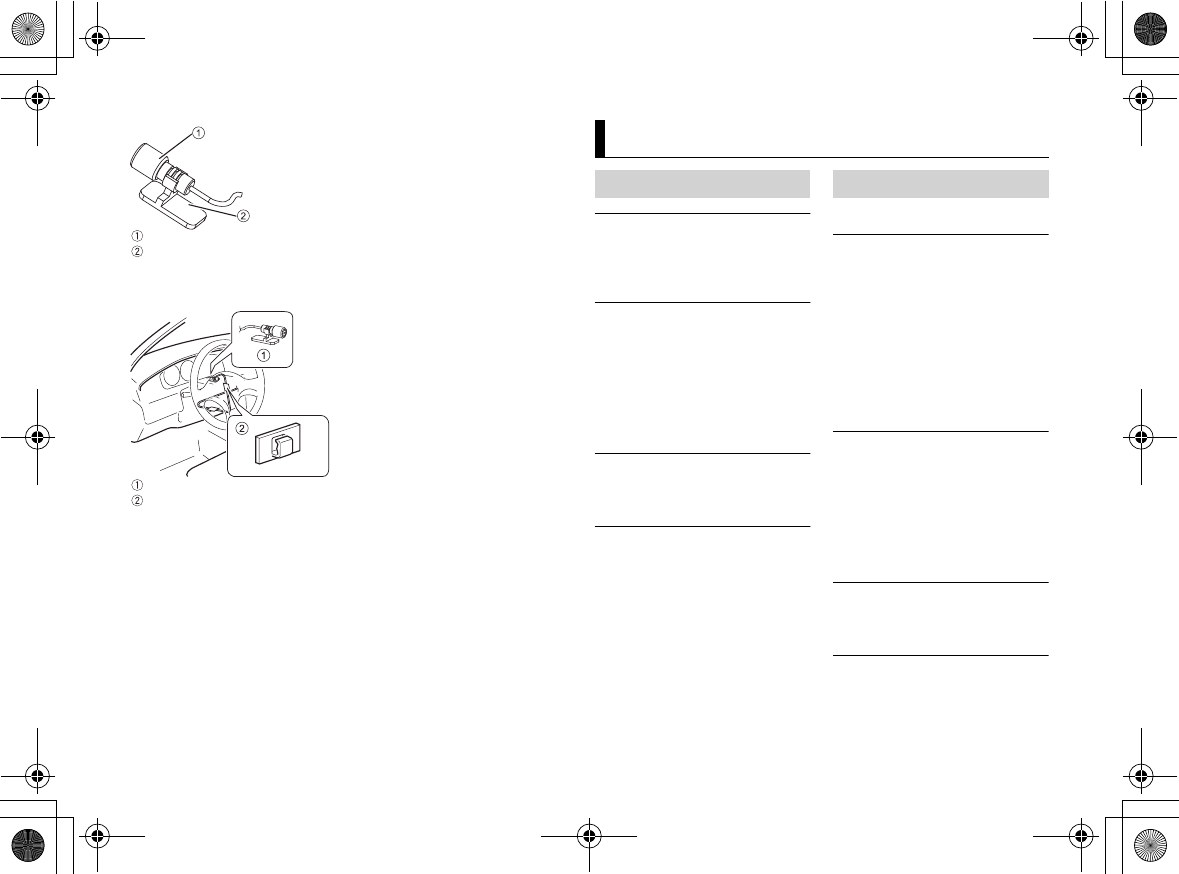
16
C:\Program Files (x86)\Adobe\AdobeFrameMaker12\Structure\xml\Pioneer\1.0\020Chapter.fm
KM637
KM637_UC
En
2Attach the microphone on the
steering column.
3Keeping it away from the steering
wheel.
Additional Information
Troubleshooting
Microphone
Microphone clip
Microphone Base
Clamps
Use separately sold clamps to
secure the lead where
necessary inside the vehicle.
The display automatically returns to
the normal display.
→No operations have been made for
about 30 seconds.
– Perform an operation.
The repeat play range changes
unexpectedly.
→Depending on the repeat play
range, the selected range may
change when another folder or
track is being selected or during
fast forwarding/reversing.
– Select the repeat play range
again.
A subfolder is not played back.
→Subfolders cannot be played when
[FLD] (folder repeat) is selected.
– Select another repeat play range.
The sound is intermittent.
→You are using a device, such as a
cellular phone, that may cause
audible interference.
– Move electrical devices that may
be causing the interference away
from the unit.
Error messages
Common
AMP ERROR
→This unit fails to operate or the
speaker connection is incorrect.
→The protective circuit is activated.
–Check the speaker connection.
–Turn the ignition switch OFF and
back to ON again. If the message
remains, contact your dealer or an
authorized Pioneer Service
Station for assistance.
USB device
NO AUDIO
→There are no songs.
–Transfer the audio files to the USB
device and connect.
→The connected USB device has
security enabled.
–Follow the USB device
instructions to disable the
security.
SKIPPED
→The connected USB device contains
DRM protected files.
–The protected files are skipped.
PROTECT
→All the files on the connected USB
device are embedded with DRM.
–Replace the USB device.
PioneerTest.book Page 16 Wednesday, May 11, 2016 9:52 AM
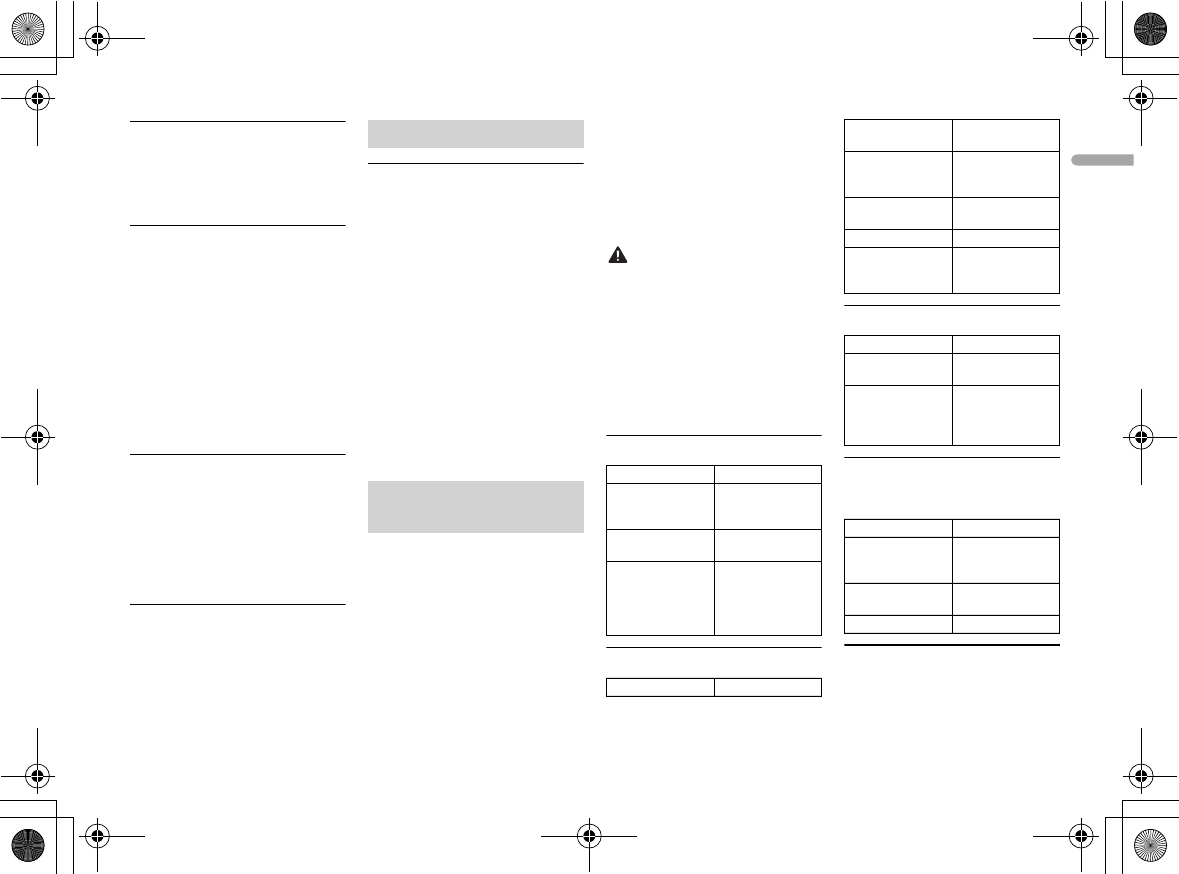
17
C:\Program Files (x86)\Adobe\AdobeFrameMaker12\Structure\xml\Pioneer\1.0\020Chapter.fm
KM637
KM637_UC
En
English
N/A USB
→The connected USB device is not
supported by this unit.
–Disconnect your device and
replace it with a compatible USB
device.
CHECK USB
→The USB connector or USB cable
has short-circuited.
–Check that the USB connector or
USB cable is not caught in
something or damaged.
→The connected USB device
consumes more than maximum
allowable current.
–Disconnect the USB device and
do not use it. Turn the ignition
switch OFF and back to ACC or
ON. Connect only compliant USB
devices.
ERROR-19
→Communication failed.
–Perform one of the following
operations, then return to the
USB source.
•Turn the ignition switch OFF and
back to ON.
•Disconnect the USB device.
•Change to a different source.
ERROR-23
→USB device was not formatted
properly.
–Format the USB device with
FAT12, FAT16 or FAT32.
Handling guidelines
USB storage device
•Connections via USB hubs are not
supported.
•Firmly secure the USB storage device
before driving. Do not let the USB
storage device fall onto the floor,
where it may become jammed under
the brake or accelerator pedal.
•Depending on the USB storage
device, the following problems may
occur.
–Operations may vary.
–The storage device may not be
recognized.
–Files may not be played back
properly.
–The device may cause audible
interference when you are listening
to the radio.
Compressed audio
compatibility
•Only the first 32 characters can be
displayed as a file name (including
the file extension) or a folder name.
•The unit may not work properly
depending on the application used
to encode WMA files.
•There may be a slight delay at the
start of the playback of audio files
embedded with image data, or audio
files stored on a USB device with
numerous folder hierarchies.
•Russian text to be displayed on this
unit should be encoded in one of the
following character sets:
–Unicode (UTF-8, UTF-16)
–A character set other than Unicode
that is used in a Windows
environment and is set to Russian
in the multi-language setting
CAUTION
•Pioneer cannot guarantee
compatibility with all USB mass
storage devices, and assumes no
responsibility for any loss of data on
media players, smartphones, or
other devices while using this
product.
•Do not leave discs or a USB storage
device in any place that is subject to
high temperatures.
WMA files
File extension .wma
Bit rate 48 kbps to 320 kbps
(CBR), 48 kbps to
384 kbps (VBR)
Sampling
frequency
32 kHz, 44.1 kHz, 48
kHz
Windows Media™
Audio Professional,
Lossless, Voice/
DRM Stream/
Stream with video
Not compatible
MP3 files
File extension .mp3
Bit rate 8 kbps to 320 kbps
(CBR), VBR
Sampling
frequency
16 kHz to 48 kHz (32
kHz, 44.1 kHz, 48
kHz for emphasis)
Compatible ID3 tag
version
2.2, 2.3, 2.4
M3u playlist Not compatible
MP3i (MP3
interactive), mp3
PRO
Not compatible
WAV files
File extension .wav
Quantization bits 8 and 16 (LPCM), 4
(MSADPCM)
Sampling
frequency
16 kHz to 48 kHz
(LPCM), 22.05 kHz
and 44.1 kHz (MS
ADPCM)
FLAC files
•FLAC files may not be playable,
depending on the encoder.
File extension .flac
Sampling
frequency
8/11.025/12/16/
22.05/24/32/44.1/
48 kHz
Quantization bit
rate
16 bit
Channel mode 1/2 ch
USB device
•There may be a slight delay when
starting playback of audio files on a
PioneerTest.book Page 17 Wednesday, May 11, 2016 9:52 AM
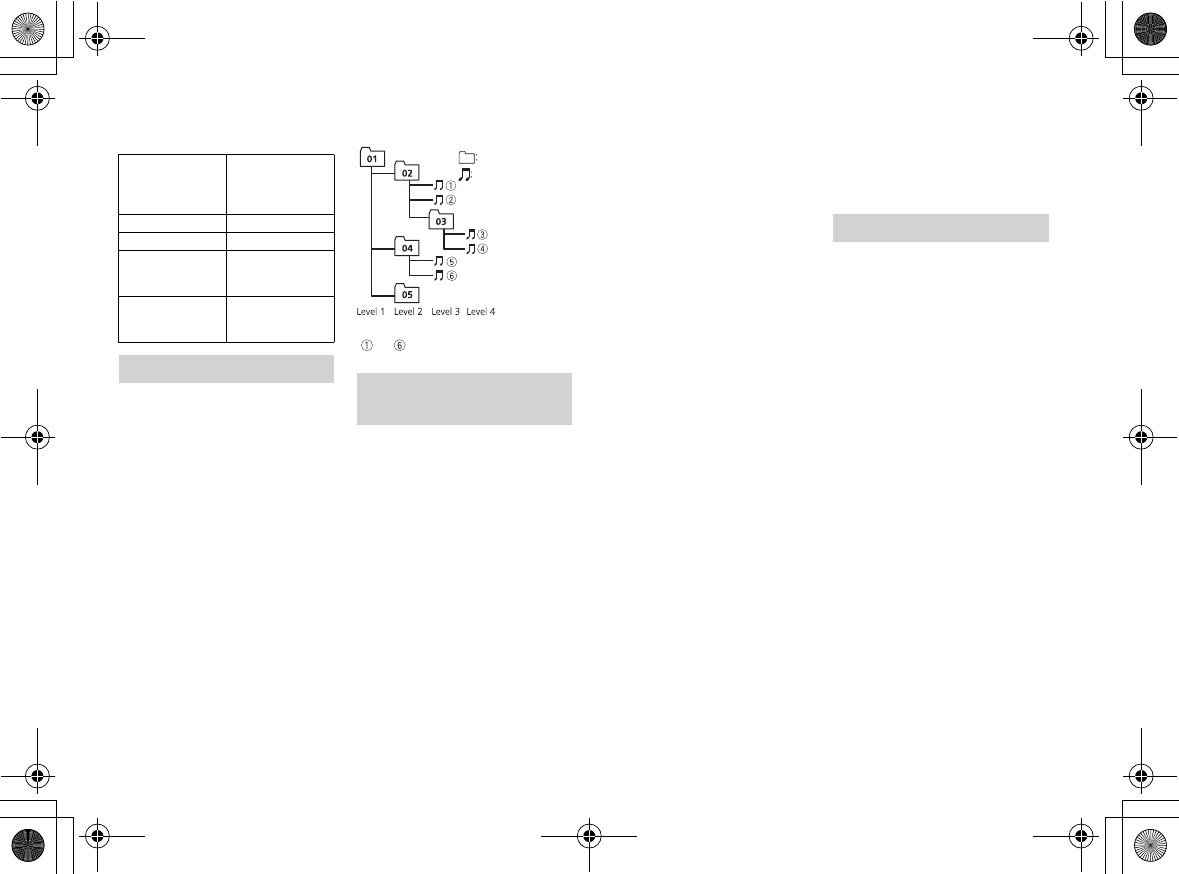
18
C:\Program Files (x86)\Adobe\AdobeFrameMaker12\Structure\xml\Pioneer\1.0\020Chapter.fm
KM637
KM637_UC
En
USB storage device with numerous
folder hierarchies.
Playable folder
hierarchy
Up to eight tiers (A
practical hierarchy
is less than two
tiers.)
Playable folders Up to 500
Playable files Up to 15 000
Playback of
copyright-
protected files
Not compatible
Partitioned USB
device
Only the first
partition can be
played.
Sequence of audio files
The user cannot assign folder
numbers and specify playback
sequences with this unit. Sequence of
audio file depends on the connected
device.
Note that the hidden files in a USB
device cannot be played back.
Example of a hierarchy
Copyright and
trademark
WMA
Windows Media is either a registered
trademark or trademark of Microsoft
Corporation in the United States and/
or other countries.
This product includes technology
owned by Microsoft Corporation and
cannot be used or distributed without
a license from Microsoft Licensing, Inc.
FLAC
Copyright © 2000-2009 Josh Coalson
Copyright © 2011-2013 Xiph.Org
Foundation
Redistribution and use in source and
binary forms, with or without
modification, are permitted provided
that the following conditions are met:
Folder
Compressed
audio file
to : Playback sequence
01 to 05: Folder number
–Redistributions of source code must
retain the above copyright notice,
this list of conditions and the
following disclaimer.
–Redistributions in binary form must
reproduce the above copyright
notice, this list of conditions and the
following disclaimer in the
documentation and/or other
materials provided with the
distribution.
–Neither the name of the Xiph.org
Foundation nor the names of its
contributors may be used to endorse
or promote products derived from
this software without specific prior
written permission.
THIS SOFTWARE IS PROVIDED BY THE
COPYRIGHT HOLDERS AND
CONTRIBUTORS “AS IS” AND ANY
EXPRESS OR IMPLIED WARRANTIES,
INCLUDING, BUT NOT LIMITED TO, THE
IMPLIED WARRANTIES OF
MERCHANTABILITY AND FITNESS FOR
A PARTICULAR PURPOSE ARE
DISCLAIMED. IN NO EVENT SHALL THE
FOUNDATION OR CONTRIBUTORS BE
LIABLE FOR ANY DIRECT, INDIRECT,
INCIDENTAL, SPECIAL, EXEMPLARY, OR
CONSEQUENTIAL DAMAGES
(INCLUDING, BUT NOT LIMITED TO,
PROCUREMENT OF SUBSTITUTE
GOODS OR SERVICES; LOSS OF USE,
DATA, OR PROFITS; OR BUSINESS
INTERRUPTION) HOWEVER CAUSED
AND ON ANY THEORY OF LIABILITY,
WHETHER IN CONTRACT, STRICT
LIABILITY, OR TORT (INCLUDING
NEGLIGENCE OR OTHERWISE) ARISING
IN ANY WAY OUT OF THE USE OF THIS
SOFTWARE, EVEN IF ADVISED OF THE
POSSIBILITY OF SUCH DAMAGE.
Android™
Android is a trademark of Google Inc.
Specifications
General
Power source: 14.4 V DC (10.8 V to 15.1
V allowable)
Grounding system: Negative type
Maximum current consumption: 10.0
A
Dimensions (W × H × D):
DIN
Chassis: 178 mm × 50 mm × 97
mm
Nose: 188 mm × 58 mm × 17 mm
D
Chassis: 178 mm × 50 mm × 97
mm
Nose: 170 mm × 46 mm × 17 mm
Weight: 0.5 kg
Audio
Maximum power output:
• 50 W × 4 ch/4 Ω (for no
subwoofer)
• 50 W × 2 ch/4 Ω + 70 W × 1 ch/2
Ω (for subwoofer)
Continuous power output:
22 W × 4 (50 Hz to 15 000 Hz, 5 %
THD, 4 Ω load, both channels
driven)
Load impedance: 4 Ω (4 Ω to 8 Ω
allowable)
Preout maximum output level: 2.0 V
PioneerTest.book Page 18 Wednesday, May 11, 2016 9:52 AM
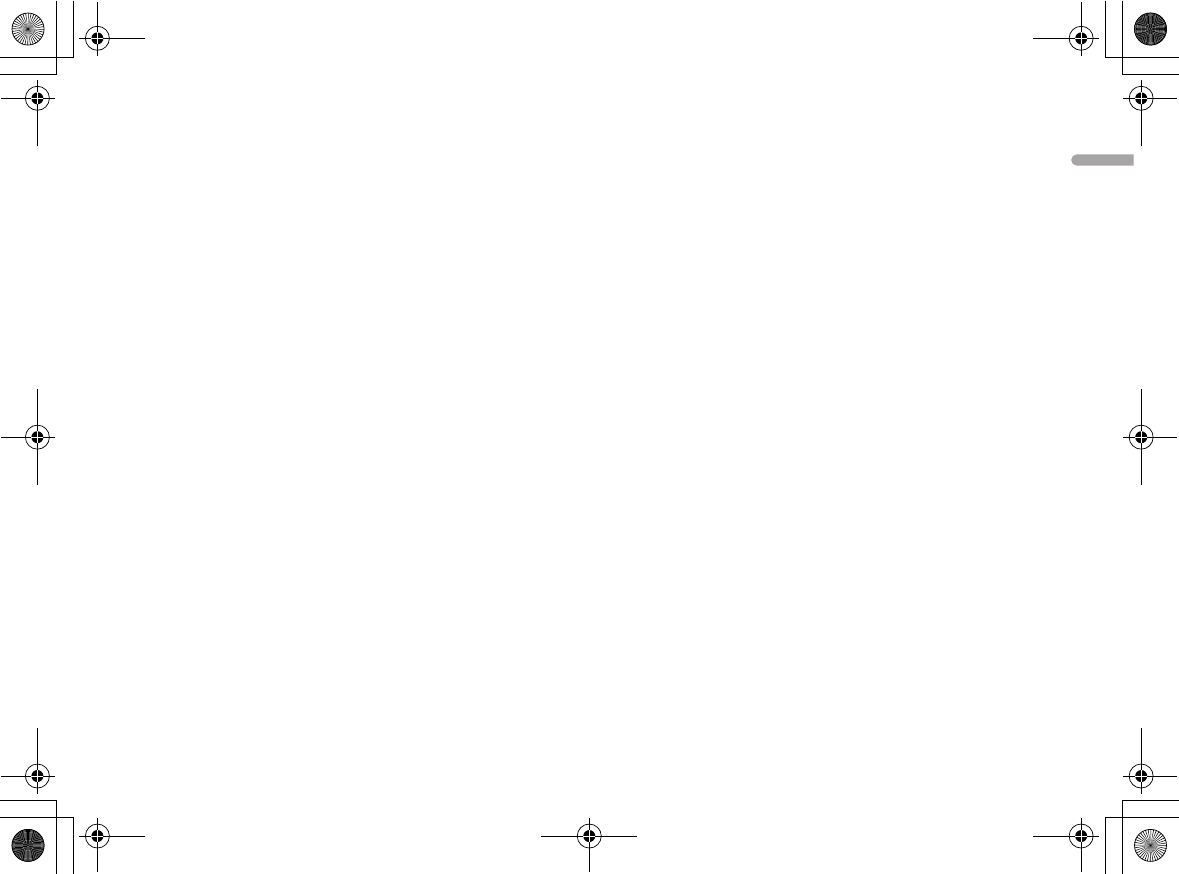
19
C:\Program Files (x86)\Adobe\AdobeFrameMaker12\Structure\xml\Pioneer\1.0\020Chapter.fm
KM637
KM637_UC
En
English
Loudness contour: +10 dB (100 Hz),
+6.5 dB (10 kHz) (volume: –30 dB)
Equalizer (5-Band Graphic Equalizer):
Frequency: 80 Hz/250 Hz/800 Hz/
2.5 kHz/8 kHz
Equalization range: ±12 dB (2 dB
step)
Subwoofer (mono):
Frequency: 50 Hz/63 Hz/80 Hz/
100 Hz/125 Hz/160 Hz/200 Hz
Slope: –12 dB/oct, –24 dB/oct
Gain: +6 dB to –24 dB
Phase: Normal/Reverse
USB
USB standard specification: USB 2.0
full speed
Maximum current supply: 500 mA
USB Protocol:
MSC (Mass Storage Class)
AOA (Android Open Accessory)
2.0
File system: FAT12, FAT16, FAT32
MP3 decoding format: MPEG-1 & 2
Audio Layer 3
WMA decoding format: Ver. 7, 7.1, 8, 9
(2 ch audio) (Windows Media
Player)
FLAC decoding format: v1.3.0 (Free
Lossless Audio Codec)
WAV signal format: Linear PCM & MS
ADPCM (Non-compressed)
FM tuner
Frequency range:
87.9 MHz to 107.9 MHz
Usable sensitivity: 11 dBf (1.0 μV/75 Ω,
mono, S/N: 30 dB)
Signal-to-noise ratio: 72 dB (IEC-A
network)
AM tuner
Frequency range: 530 kHz to 1 710 kHz
Usable sensitivity: 25 μV (S/N: 20 dB)
Signal-to-noise ratio: 62 dB (IEC-A
network)
Bluetooth
Version: Bluetooth 3.0 + EDR certified
Output power: +4 dBm Maximum
(Power class 2)
Frequency band(s): 2 400 MHz to 2
483.5 MHz
Bluetooth profiles:
GAP (Generic Access Profile)
SDAP (Service Discovery
Application Profile)
HFP (Hands Free Profile) 1.6
PBAP (Phone Book Access Profile)
A2DP (Advanced Audio
Distribution Profile)
AVRCP (Audio/Video Remote
Control Profile) 1.5
SPP (Serial Port Profile) 1.1
NOTE
Specifications and the design are
subject to modifications without
notice.
PioneerTest.book Page 19 Wednesday, May 11, 2016 9:52 AM
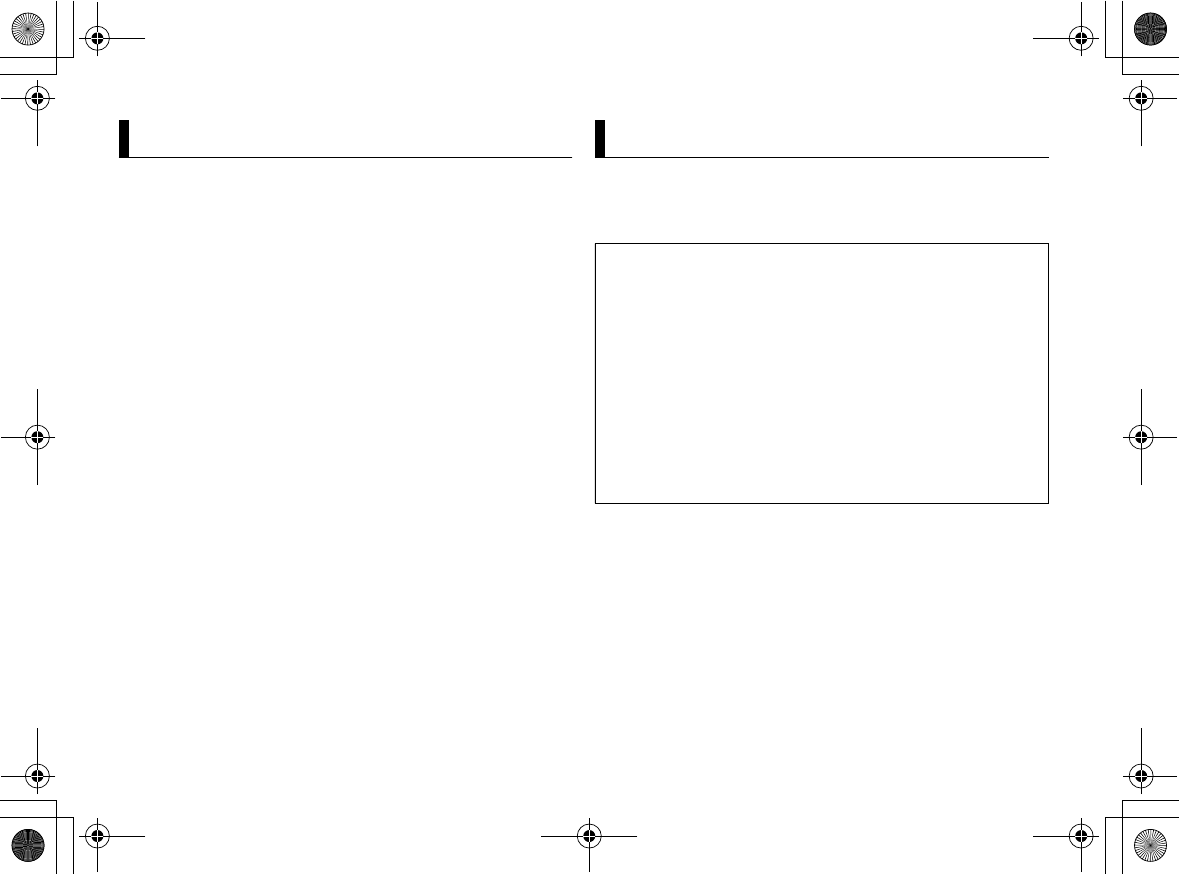
Table des matières
2
C:\Program Files (x86)\Adobe\AdobeFrameMaker12\Structure\xml\Pioneer\1.0\020Chapter.fm
KM637
KM637_UC
Fr
Avant de commencer................................................................ 2
Pour commencer........................................................................ 3
Radio ............................................................................................ 6
USB/AUX...................................................................................... 6
Bluetooth..................................................................................... 8
Réglages .................................................................................... 11
Réglages FUNCTION ............................................................. 11
Réglages AUDIO..................................................................... 12
Réglages SYSTEM .................................................................. 12
Connexions/Installation ......................................................... 13
Informations complémentaires ............................................ 17
À
propos de ce manuel :
•Dans les instructions suivantes, une mémoire USB ou un lecteur audio USB
est nommé « périphérique USB ».
Avant de commencer
Nous vous remercions d’avoir acheté cet appareil PIONEER
Pour garantir une utilisation adéquate, lisez bien ce mode d’emploi avant d’utiliser cet
appareil. Il est particulièrement important que vous lisiez et respectiez les indications
ATTENTION et PRÉCAUTION de ce mode d’emploi. Conservez-le dans un endroit sûr et
facilement accessible pour toute consultation ultérieure.
ID FCC : AJDK096
MODÈLE Nº : MVH-290BT/MVH-291BT
IC : 775E-K096
Le présent appareil est conforme aux la partie 15 des règles de la FCC et CNR
d’Innovation, Sciences et Développement économique Canada applicables aux appareils
radio exempts de licence. L’exploitation est autorisée aux deux conditions suivantes: (1)
l’appareil ne doit pas produire de brouillage, et (2) l’utilisateur de l’appareil doit accepter
tout brouillage radioélectrique subi, même si le brouillage est susceptible d’en
compromettre le fonctionnement.
L'antenne Bluetooth ne peut pas etre supprime (ou remplace) par l'utilisateur.
Cet équipement est conforme aux limites d’exposition aux rayonnements de la FCC/ISDE
énoncées pour un environnement non contrôlé et respecte les directives relatives à
l’exposition aux radiofréquences (RF) de la FCC et le règlement CNR-102 relatif à
l’exposition aux radiofréquences (RF) d’ISDE. Cet équipement émet une énergie RF très
faible qui est considérée conforme sans évaluation de l’exposition maximale autorisée.
Cependant, cet équipement doit être installé et utilisé en gardant une distance de 20cm
ou plus entre le dispositif rayonnant et le corps (à l’exception des extrémités : mains,
poignets, pieds et chevilles).
La protection de votre ouïe est entre vos mains
Pour assurer le rendement optimal de votre matériel et – plus important encore – la
protection de votre ouïe, réglez le volume à un niveau raisonnable. Pour ne pas altérer votre
sens de la perception, le son doit être clair mais ne produire aucun vacarme et être exempt
de toute distorsion. Votre ouïe peut vous jouer des tours.
Avec le temps, votre système auditif peut en effet s’adapter à des volumes supérieurs, et ce
qui vous semble un « niveau de confort normal » pourrait au contraire être excessif et
contribuer à endommager votre ouïe de façon permanente. Le réglage de votre matériel à
un volume sécuritaire AVANT que votre ouïe s’adapte vous permettra de mieux vous
protéger.
CHOISISSEZ UN VOLUME SÉCURITAIRE :
•Réglez d’abord le volume à un niveau inférieur.
•Montez progressivement le volume jusqu’à un niveau d’écoute confortable ; le son doit
être clair et exempt de distorsions.
PioneerTest.book Page 2 Wednesday, May 11, 2016 9:58 AM